|
|
|
We have started eating healthier. |
|
|
I am more compassionate to others. My circle of compassion has expanded. |
|
|
VSIG was started and has touched many lives. |
|
|
We started a local chapter of EarthSave International in Cocoa Beach. |
|
|
We have simplified our lives. |
|
|
I wrote a book and created a web page. |
|
|
I have been invited to speak to different groups. I even spoke at an "Alliance for Holistic Healing" meeting. If you had told me years ago that I would be speaking to them about preventative medicine, I would have thought you were crazy. |
|
|
I have met some wonderful, famous doctors and health practitioners (John McDougall, Neal Barnard, Michael Klapper, Lee Hitchcox). |
|
|
I have even been reacquainted with old friends who have also been affected by vitiligo. |
|
|
We have made friends with other parents, whose children have vitiligo. |
Spontaneous Repigmentation
I
have read about spontaneous repigmentation in vitiligo patients. Call it the
engineer (read engin-nerd for those of you married to one) in me, but
I have a hard time believing the spontaneous part of the repigmentation. I
believe there must have been some kind of a lifestyle change or behavior
modification that came first, IMHO. I believe that if it went away something
changed that made it go away. The use of these two words seems to me to be
the easy way out. Any case of spontaneous repigmentation should be cataloged
and closely studied. This is where the cure for vitiligo will come
from, not from studying animal models. Even if
it was caused by a hormonal change as an individual passed through a life
change.
I have had a friend joke
"so looks like Emily grew out of it", even though I knew he was
joking it drove me crazy. It is like saying I just grew out of my high cholesterol problem. I think the reason I have
problems with phrases like these is, I may never be able to prove beyond a
shadow of a doubt that Emily did not "just grow out of it" or that
it wasn't spontaneous repigmentation. I can only sympathize with Dr. Dean
Ornish, when he was trying to prove that he could reverse heart disease with
lifestyle changes. Of course Ornish finally did prove that he could reverse
heart disease, so one day I may be able to prove that Emily's repigmentation
wasn't spontaneous. I do believe that lifestyle changes can change the course
of disease, and I believe I have seen this many times in my own family.
A study using techniques
similar to the ones that Dr. Ornish used could easily be performed on
vitiligo patients. Using a control group and a group following the methods I
describe later in this book, nutrition, mind body counseling, natural psoralen,
and support groups. We would take pictures of all the patients. The control
group would go to their dermatologist and follow the standard advice. At
yearly intervals we could see the results, statistically we could compare the
progress made by each group.
Another study would involve
vitiligo affected human skin grown in a laboratory. Using varying amounts of
the vitamins mentioned by Dr. Montes in Vitiligo, Nutritional Therapy
we could test their effect on skin that contained vitiligo. In this experiment
you may need to vary the skin types (darker and lighter, hairy and not hairy)
and vitiligo types (symmetrical, segmental).
It has also occurred to me
that we might use population studies to help understand why a country like
India (8.8%) could have such a high rate of vitiligo, while the United States
(1%), Europe (0.4%) and Russia (0.1%) have comparatively low rates.
We could study this thing
to death but right now there are many people looking for a safe and effective
treatment. It reminds me of the following story told by Denis Burkitt, MD, in
Foods Can Save Your Life by Neal Barnard. Dr. Burkitt had just
finished a speech about colon cancer and its relationship to diverticular
disease and going further its relationship to a lack of dietary fiber. A man
approached him and said
'I
understand what you are talking about, but I'm not going to advise anybody
until I understand all the mechanisms and have double-blind trials, and what
have you.' 'Well,' I said, Diverticular disease is going to take a sixty-year
trial, so it'll be your grandson writing up the last paper. If you were on a
pier and your son fell into the water, I know what you'd do. If you had a
life jacket in your hand, you wouldn't throw it to him. You'd say, "I'm
not sure of the specific gravity of this life jacket, and I don't really know
whether it fits my son. I think I'll go back to the lab. I'll do three more
weeks' work on my life jacket, then I'll come back to the harbor and, if
Jimmy's still swimming around, I'll throw him the life jacket'
There are a
lot of vitiligo patients out there that need a life jacket, unfortunately
there aren't any coast guard approved jackets laying around. Do not despair,
there are clues available to safe treatments that can keep you afloat, they
may even get you back to shore.
You
Are Not Alone
One
percent (1%) of the world population is estimated to have vitiligo, which is
one person out of one hundred. That may seem like a large percentage. When I
first heard that number I said, no way, it couldn't be, I thought it had to
be a smaller percentage, I just couldn't remember seeing that many people
with vitiligo. The more you think about it, people use camouflage, cover up
with clothing or just have a minor case of it. I was surprised to find out
that a neighbor has it, two of the guys I work with have it and a close
friend has it. I remember seeing someone with vitiligo once as a child, a
friend and I, were at the local gas station. I asked my friend and he told me
very seriously that it came about because the person spilled gasoline on
herself. At the time I accepted his analysis, now I know better. For a long
time I avoided gasoline.
Dr. Leopoldo Montes and his
book Vitiligo, Nutritional Therapy has helped us formulate a
nutritional regime for Emily. In a letter I received from Dr.
Montes on 6-13-95 he told me "Leading vitiligo experts in India, a
country with about 8% of the population suffering from vitiligo, agree that
the nutritional basis for many cases of this condition are real." From
what I understand India is a country with a high percentage of malnourished
people. I have read on VSIG
that in India, young girls that have vitiligo are ostracized. Fortunately in
the US (land of the Barbie doll) it is not currently that bad, but the outer
image is still very important to many. We may not ostracize the person openly
and publicly as in India, we do it subtly. Where people are not accepted into
the in group, for whatever reason. I do believe we are becoming a more
open and accepting society in general, it is just in less educated pockets
that you might see this kind of thinking. Later in this book I will describe
in detail the nutritional approach we follow.
Looser, looser, double
looser, as if, whatever, get the picture, duh!
-My children, talking to
me, totally, for sure.
For now let's look at a few
posts from VSIG on the subject of India and Vitiligo. I have included them
here to give you an example of some of the variety of information you will
read about on VSIG. They also allude to the strategy that we have been
successful with.
Message
Number 1 of 3:
Subject: [VITILIGO] Cultural attitudes
This is the Vitiligo Support and Information Group (VSIG)
Hi all,
I've been
sitting here musing. It's a glorious summer day; I'm wearing a sleeveless
top, which shows off several of my patches to their best advantage, and long
trousers. Why the trousers? Well, for one thing I feel more comfortable in
them, but specifically today - well, to be frank, I didn't have time to shave
my legs this morning. This got me thinking - why don't I mind showing my
patches, but I'm shy about body hair? I've got a theory on that: does anyone
remember some of the rather cruel jokes that used to make the rounds about
Germanic (German, Swedish etc.) girls' underarm hair? I walked straight into
that when I first came to England as a happily hairy 20-year-old Swiss girl.
I've been here ever since, give or take a couple of years, and guess what?
I've gone through the full range of hair-removing equipment. So it's not as
though I'm insensitive to others' opinion of my appearance...
And all
that got me wondering has anybody done any research on attitudes to vitiligo
(by both people who have it and the societies they live in) in different
cultures/countries? In particular, in cultures which are basically of
Northern European extraction? Are for example Swedes, who seem to have a
pretty relaxed attitude to their bodies in general, less bothered about it?
Or is the issue one of conformity, and whether one society tolerates
"deviance from the norm" more easily than another? Slightly
off-topic, I admit and apologize, but it might be useful to think these
things over to get to the bottom of what it actually is that bothers us about
our vitiligo. Any opinions?
Message
Number 2 of 3:
Subject: Re: [VITILIGO] Cultural attitudes
This is the Vitiligo Support and Information Group (VSIG)
Hi Peps I
remember reading once that Gandhi said vitiligo caused a lot of suffering in
India because people often confused it with leprosy. Those who had vitiligo
were shunned; don't know if it's still the same today. He hoped there would
be a cure found soon. Don't we all?
best wishes
Elizabeth
Message
Number 3 of 3:
Subject: Re: [VITILIGO] Cultural attitudes
This is the Vitiligo Support and Information Group (VSIG)
Hi
Elizabeth:
Yes, people in rural parts of India (mostly uneducated) still Confuse
Vitiligo with Leprosy and yes they are shunned even today. Especially young
girls who develop this condition during their puberty and teen years in
villages live a terrible life. Most never get married; many rely on their
extended families to take care of them for life. Someday I will post actual
case studies (makes interesting reading) from my grandpa's medical files (he
was a Dr. of traditional Indian medicine called 'Ayurveda', practiced for 45
years and passed away in 1981).
By the way,
for the benefit of diet advocates on this list, my grandpa treated a lot of
Vitiligo Patients during his medical career and he always put them on special
diet for at least six weeks and special purgatives for one week before
treating them with "Bavachi" extract (Plant Psoralens in natural
form) and sunlight. The special diet was very simple, almost fat free and
excluded many food items like Onions, cheeses, meat, milk/milk products,
fried stuff (no oils), alcohol, tobacco and some hot spices. [Could we now
theorize that may be these foods cause higher intradermal production/accumulation
of H2O2 in Catalase deficient patient?] He always maintained that inadequate
sleep and fatty diet in wrong combination produced vitiligo in genetically
predisposed individuals. This condition was only treatable in some
individuals if the diet and lifestyle were corrected first followed by
Psoralen/natural sun light. Success depended on the age of vitiligo condition
(older patches were difficult to treat) and patient's adherence to this
strict regimen. He also once mentioned that Vitiligo was a
"condition" not a "disease" and was manifestation of
different but related causes in different patients. That is why this
treatment was not suitable for some. (This might explain unsuccessful double
blind studies).
Well, I
only wrote this (a boring article) to open up a healthy debate on this
subject and may be inviting subscribers who have already experimented with
strict diet regimens to hear their stories. The worst thing you can do is to
eat onions and drink milk (or milk products) in a single sitting (this makes
Pizza with cheese and onions a bad combination food) and then starve the body
of sleep. Anybody with experience out there?
Regards,
S. Shah, MS
Rigidity
of Modern Medicine
Could
nutrition effect health? The food we eat three times a day. I began to read
about doctors who were successful with nutritional therapy or using nutrition
preventatively for a variety of diseases like heart disease, diabetes, cancer
and vitiligo. The problem was none of the local doctors had heard of it. We
had a pediatrician and two dermatologists tell us there was nothing we could
do, ignore it, live with it. They said she was too young for PUVA. Turns out
now that I am glad they said these things. It helped us open our minds to
look for alternatives, to ask questions. We just couldn't accept what they
told us. Our doctors didn't even recommend steroids, which some doctors do
recommend for vitiligo. I am glad we didn't use steroids, but I am not
knocking any parent or vitiligo patient that is using them. If things had
been different in our lives we may have went that direction. I just want to
say that at this point, looking back on our journey, I am glad we didn't have
to make that choice. I have concerns about the drugs that we are asked to use
by our doctors. I am concerned about steroids and their immune suppressing
effect. I might be willing to use it for a short period, but not for a long
term treatment and vitiligo requires a long-term lifestyle change.
My father was dying as I
wrote this book. He had prostate cancer, coronary heart disease, diabetes and
the cancer had moved to his bones and lungs. I had to witness firsthand what
happens when you don't practice preventative medicine. It is very painful to
watch, but it is also showing me and I hope my children, the benefits of
living a simpler lifestyle. More in touch with nature, more compassionate. If
you are lucky it may help reverse your vitiligo, I know for certain it will
help in other areas of your life. My Dad was taking a soup of different
drugs, at least seven different drugs from four different doctors. An
interesting side note is that the doctors were giving my father rat poison to
thin his blood. Yet when I asked if it was all right to give him an enzyme
pill to help him digest his food, they became very concerned about the health
implications of giving him these enzymes. I realize the reason that the rat
poison was used and I also realize it was used in minute doses. It is just in
this atmosphere where doctors get frequent flyer miles to prescribe high blood
pressure medicine. Chemical companies make money without consideration for
the damage they do to the environment. The chemicals they make are then
studied for their effects on humans (using animal
models). There seems to be no money available to test the simplest of
herbs, and prevention is barely taught. We live in a very strange time in
medical history.
I am sorry to imply blame on
anyone. I am not interested in blame or in judgment in any way. I do not
blame my Dad for his prostate cancer, just as I don't blame anyone for his or
her vitiligo. All I am saying is that, in my humble opinion, we can have a
positive effect on our health by following some basic preventative
guidelines. For instance in 1996 the American Cancer Society said
"Increase of risk of prostate cancer is associated with animal fat, red
meats and dairy products, suggesting that saturated fat may be
involved." Of course this was too late for my
father, if he had known this 50 years ago, he might have had a chance. My
father was a lively and vibrant 70-year-old, who was stopped, in his tracks
by this disease. I believe that we can use this same preventative
information, to produce an environment that will promote healing, even for
vitiligo. Blame is not part of healing.
"How good it is to be
well-fed, healthy, and kind all at the same time!"
Henry
Heimlich, M.D. (invented Heimlich Maneuver)
In any statistical sample
there will be an outlier, like Winston Churchill or George Burns, don't let
their success stop you from taking positive action today for your own health.
I believe it will help your vitiligo, and I guarantee it will help other
areas of your health and the health of your family. Future generations will
benefit from the changes you make today. These new habits once learned by
your children will be passed on for many generations to come. If you don't
have children, your actions will have a tremendous effect on your friends.
Most people are interested in living a healthier lifestyle; we just need
positive role models to help us along the way. As we change our lifestyles we
become those positive role models. Others realize that if you can do it, they
can too.
You are probably asking,
what changes? What does cancer have to do with vitiligo and saturated fat?
Trust me I will get there, eventually.
Peter Lynch, in his book One
Up On Wall Street, said that the individual investor has a better chance
of making money in the market than the large institutional investors. He
reasoned that the individual was not encumbered by the rules that the
institutions were under. They could buy as little or as much of any stock in
any sector that they had funds to invest. In the same way, I believe
individuals have a better chance of healing themselves or their loved ones,
of a chronic disease like vitiligo, than a doctor does. The doctors are
restricted by the AMA and the FDA as to which drugs they can use to cure
someone. A doctor may not see it this way, these organizations have been put
in place to standardize and test available treatments. Doctors must also be
concerned about litigation. There are financial incentives for doctors to
prescribe certain drugs. Medical insurance companies discourage services that
are outside of the standard. The problem is that instead of being about
healing, it has become a moneymaking juggernaut. Often times the high ideals
required for healing are not always the same ones required for making money.
In the current environment if your doctor were interested in trying some kind
of "mind body" approach to healing, other doctors would in my opinion,
ridicule them for being unscientific. In the current environment they can't
even consider herbs or vitamins. Medical practitioners must feel trapped
within this double blind system, at least when they deal with chronic
disease. Money and fear double blind the system.
I actually feel sorry for
the dermatologist that said there was nothing that we could do. He had worked
himself into a belief that it was his way or the highway. It was his belief
that the alternative health care professions don't offer anything. He must
have felt that the millions of people who spend their money on alternatives
are just wasting their money. When he told us to go home and just live with
it, I wonder if he really believed that he had earned the fee he charged.
There is wisdom in the large group of people choosing alternative
health care, and their wisdom should not be discounted.
An unexpected feeling is
gratitude, I am actually grateful for the unbending belief of modern
medicine. This rigid belief that their way is the only way, helped wake me
up. It made me realize that there is never just one way. It helped me to
search for a way that would work in our family.
We had taken the first
step, in our case the parents had to heal before the child. We had to face
the problem and we were now ready to do so. Then we could take the small
steps required to solve any puzzle. This took a long time but it was the
foundation of our future work.
![]()
Chapter 3
Lifestyle
Next
step in puzzle solving was to find the pieces with the straight edges. I like
to work the border first. This gives me a frame to work in. In this regard
our treatment was to rearrange our lifestyle. We brought our lifestyle into
alignment with healthy living. We changed our food choices and simplified our
lives.
Why Have We Done This?
Emily's
vitiligo made us reevaluate our entire lives. Anytime the conversation about
health came up and it is surprising how often this happens, we listened. We did
a lot of listening and reading. So I started researching the disease and
health in general. At the time I had a cholesterol
level of 242 (2 points away from the average for a heart attack victim, 244)
and I was experimenting with natural ways to reduce my cholesterol.
My father had adult onset diabetes, which he controlled for years with a pill
and had just started injecting insulin a few years earlier. My blood sugar
level had just crossed the threshold into the high range. So there were a lot
of good reasons to start studying and changing. I could accept that these
things were my inherited traits, which I could do nothing about, or I could
do something about them. I chose the high road.
Loyalty to a petrified
opinion never broke a chain or freed a human soul.
Mark Twain
Dr.'s didn't have much to
offer Emily in the way of a cure and in fact what they did offer had the
potential to screw up her liver. We went to the local library and read the Physicians’
Desk Reference concerning the pharmaceutical grade psoralens one
dermatologist recommended, it didn't give us a warm feeling. Most doctors
said we shouldn't do anything until she was 12 years old. Their PUVA
treatment didn't exactly offer me much hope. After reading the next quote
(Klaus, S. and Lerner, A. B., Vitiligo. Journal of the American Academy of
Dermatologists, 5:997-1000, 1984) you may see why;
A
combination of an orally ingested drug (psoralens) and the exposure to
long-wave ultraviolet light (PUVA) has become a popular form of therapy.
Although this treatment may improve the appearance of a patient it rarely
induces total repigmentation. Repigmenting therapy often takes several years
and requires a tremendous expenditure of time by both the physician and the
patient. The basic defect that led to the destruction of the pigment cells is
not corrected. Because of the disappointing results patients are often
rebuffed or advised to ignore the white patches or to cover them with cosmetics.
Then there
are the questions about how permanent the repigmentation is after using PUVA.
This caused us to lean away from PUVA, in search of a solution to the
"basic defect". Admit it if I could give you a pill a day that
would correct the "basic defect", you would pay me $500 per year,
for the rest of your life... would you be willing to change your lifestyle,
if I told you to keep the $500, keep reading.
About 30-40% of Emily's
body (chest, back, ankles, shins, knees, and neck) was depigmented at the
time, and it was increasing, we had to do something. So we looked into
non-mainstream treatments. I was studying biochemistry and looking at vitamin
therapy, I was in search of the "basic defect".
What
Have We Done?
Susie
took a vegetarian cooking class at the local hospital, she was so excited
about the class, she stopped at the local library on the way home. She picked
up a large stack of vegetarian books. When she got home she announced
"we are going vegetarian". I would like to think that because of my
humanitarianism and my feminist ideals, I embraced the idea whole-heartedly.
In actuality it was because I am lazy when it comes to preparing food. I will
cook if I absolutely have to but I am more than happy to eat what is made
available. Then I started reading the books she brought home and I was moved.
I read a book called May
All Be Fed by John Robbins. He is the guy that walked away from millions
of dollars when he decided not to take over his family’s business, Baskin-Robbins.
He wanted to take his own path; I don't think that made his father very
happy. He talked about how the food we eat gets to our table. He opened my
eyes so to speak, when he showed me how my daughter was getting sulfa-based
antibiotics. I had read in a biochemistry textbook that sulfa-based
antibiotics block the body’s ability to process folic acid, a B vitamin that
is important for healthy skin.
Here is the quote from
Introduction to Organic and Biological Chemistry, Ronald M. Scott 1980, page
294.
Tetrahydrofolic
Acid
Intestinal bacteria provide a supply of this cofactor. A deficiency, usually
termed a folacin deficiency, produces anemia. A deficiency is more likely to
occur during treatment with antibiotics, particularly with sulfa drugs. The
sulfa drugs are particularly effective because their mechanism of action is
to prevent synthesis of tetrahydrofolic acid. The sulfa drug is chemically
similar to the para-aminobenzoic acid portion of the cofactor. It is
mistakenly incorporated by the microorganism, producing a nonfunctional
cofactor.
I had
previously searched her medical records to see if she had gotten sulfa and
she hadn't. Then I read the following quote from May All Be Fed by
John Robbins, page 112.
Four
different surveys of the safety of our milk supply were conducted by
independent researchers between 1987 and 1989. The results were not
comforting, unless you like antibiotics and other veterinary drugs in your
dairy products. The studies found between 63 and 86 percent of milk samples
to contain sulfa drugs, tetracyclines, and other antibiotics. These surveys
embarrassed the FDA so much that the agency finally got around to conducting
a survey of its own. Despite using outdated methods that cannot detect small
quantities of the dangerous drug sulfamethazine, a March 1988 FDA survey
found sulfamethazine in 74 percent of the samples tested.
This finding was particularly disturbing. Sulfamethazine is a sulfa drug that
is a suspected human carcinogen.
It is an
important book that you should check out from the library sometime. Emily was
born in 1988 and after one year of breast-feeding, we put her on cows milk. After all, we are told that milk is the world's
perfect food. Unfortunately they don't tell us that it is the most perfect
food for calves. It seems to me that there is a possibility that we had given
her these antibiotics in the milk and dairy we were eating. We were eating a
lot of dairy products, I used to joke that Susie was the "cheese
queen".
Dr. Christine Northrup, a
gynecologist in Yarmouth, Maine, states, "Dairy is a tremendous mucus
producer and a burden on the respiratory, digestive and immune systems."
Dr. Northrup says when patients "eliminate dairy products for an
extended period and eat a balanced diet, they suffer less from colds and
sinus infections."
Besides the anti-biotics in
milk there is the cholesterol, saturated fat, and worst of all is the
protein. This animal protein is theorized to be involved in many autoimmune
diseases, which vitiligo is theorized to be. In 1997, I learned this at a
health show in Orlando, FL from a Dr. John McDougall (author and practicing
internist). He mentioned vitiligo in his presentation, in a long list of
autoimmune diseases he felt would one day be linked to milk intake.
There is one thing dairy
products have more of than any other food I can think of: contamination.
John A. McDougall, MD
Then there is pesticide
contamination to be concerned about. In John Robbins first book Diet for a
New America he pointed out another problem with animal protein, which had
an important connection to our family. On page 324 he writes:
...occurred
in Michigan in 1973 and 1974, and involved one of the worst cases of
pesticide poisoning yet to come to light. Here, the poison involved was PBB's
(polybrominated biphenyls). When the U.S. Congress finally investigated the
fiasco six years later, they asked expert witnesses about PBB's. The answers
were not reassuring. Impartial experts testified:
"PBB's are persistent and can be passed on for generations. PBB's are
stored in the body fat, where they can remain indefinitely. During pregnancy,
they can cross the placenta to the developing fetus...PBB is...capable of
producing physical defects in offspring in utero."
Not substances you'd particularly want in your hamburgers. Yet, in 1976
alone, several years after the PBB contamination occurred, Michigan residents
ate over 5 million pounds of hamburger contaminated with PBB's.
What had happened was that this toxic chemical had somehow gotten mixed into
livestock feed which was dispersed throughout the state. When the PBB's were
first discovered in virtually all of Michigan's meat and dairy
products, state officials tried in every way to cover up the incident. Had
the public been notified of the extreme urgency of the situation, a great
deal of tragedy could have been avoided. But as it is, according to testimony
before Michigan's Senate Commerce Subcommittee on March 29, 1977, nearly all
of Michigan's residents now have unacceptable levels of PBB's in their
bodies. It is quite likely that every single person who consumed meats, dairy
products or eggs in the state of Michigan during 1976 or 1977 now has
significant amounts of these carcinogens in his or her organs. Tests in 1976
found that 96% of nursing mothers in Michigan had PBB's in their milk.
Can you
imagine the heir to Baskin-Robbins (an ice cream chain) saying these
things? Susie is from Michigan and she turned sixteen in 1977. Our son Kyle
had a deformed baby tooth and Emily has vitiligo. I sometimes wonder if these
things were caused by PBB's. Any lawyers out there think I have a case?
Michael Klaper, MD, from
page 29 of his book Vegan Nutrition: Pure and Simple, has this to add;
Dairy
products also harbor a little discussed, but very ominous connection with
leukemia in children. As any veterinarian will verify, leukemia is common in
dairy cows and is caused by a virus, bovine leukemia virus. A cow with
leukemia passes this virus into the milk. Up to 20% of the cows in a herd may
be infected with leukemia virus. Their virus-laden milk is mixed with other
milk and sold in stores. Could the high rate of leukemia in children be
connected to their high levels of milk consumption? Denmark, the country with
the highest rate of leukemia in their cattle and in their children, has an
active program to remove leukemic cows from the dairy herd.
If you are
interested in what Robert M. Kradjian, MD, Breast Surgery Chief, Division of
General Surgery, Seton Medical Centre, Daly City, California, recommends to
his patients; please read his essay The Milk Letter: A Message To
My Patients.
I now realized that
something else affected my course of action in fighting this disease. Early
in my working career three young women (in their thirties) died from cancer.
I worked closely with all three; my desk was next to two of them. Zeanne
Houllemont (cervical cancer, Aug. ‘87), Jill White (melanoma, Jan ‘88) and
Carol Scheitauer (breast cancer, ‘92) all died after going through
conventional treatments. This was painful to watch in all three cases,
surgery, steroids, diuretics to reduce the edema caused by the steroids,
chemotherapy, radiation, more surgery, then funeral. This left me looking for
alternatives. I ended up subscribing to a newsletter by Dr. Williams called Alternatives.
Dr. Williams left me with one very important piece of information. Find out
what your relatives died of and protect yourself from those diseases. So I
did research on our families past health history. We had problems that are
all too common in America, heart disease, diabetes and cancer. My grandmother
is said to have turned white (just her hair) when she was 18. Could be
connected to vitiligo. Both of my parent's hair turned white or gray in their
early 30's.
So for all of these
reasons, in August of 1995, our whole family gave up animal products. I think
that the steady drop in my cholesterol levels over these years solidified my
belief that what we eat can affect our health. My cholesterol
is now 145 (a level where you no longer have to be concerned about ratios of
good to bad cholesterol). My blood sugar also dropped back into the normal
range.
We've never had a heart
attack in Framingham in thirty-five years in anyone who had a cholesterol
under 150. Three-quarters of the people who live on the face of this earth
never have a heart attack.
Dr. William Castelli
More importantly Emily's
vitiligo has improved greatly, for more current information see her timeline with pictures. Pictures are as important in
vitiligo, as blood tests are in heart disease. We need that feedback to make
sure we are making progress. Another benefit of our lifestyle is that our
daughter Katie has not had bronchitis since we started this lifestyle. The
year before she had it four times, as well as a constant cough and lots of
mucus.
My wife and I now weigh
what we did when we were happy about and proud of, our bodies. If you have
been trying to loose weight you will find it easier on a low-fat vegetarian
diet. When you eat fat, 3% of it is burned in converting it to body fat. When
you eat complex carbohydrates you burn 25% in the conversion to body fat. Put
simply it is easier to turn fat to fat than starch to fat. For more on weight
loss, read Eat Right, Live Longer.
Skin
as an Eliminatory Organ
It
seems simple but it needs to be said. The skin has a purpose other than being
an envelope to keep our insides from falling out. Remember that one function
of the skin is to remove toxins from the body; in this sense the skin is an
eliminatory organ. When we sweat, toxins can be eliminated through our pores.
Much of the alternative
literature that discusses healthy skin, mention that if your other organs are
backed up with waste products, then the skin will be overworked, the amount
of toxins it will have to remove will increase. I have seen pictures, in Dr. Jensen's book, of one fellow who got rid of a bad case
of psoriasis, when he went in for multiple colon cleansings. Do not read this
book when you are eating, it contains wonderful color photos of what came out
of this man.
That is one reason why we
went to a mostly vegetarian diet, high in fiber and low in fat. All that
fiber help to move things through the system and aids in eliminating toxins.
It actually reduces the amount of calories that your body derives from the
food you eat, by decreasing the transit time that food moves through your
body. It reduces fat, glucose and triglyceride levels in the blood. If all
systems are running smoothly, then the skin will have a chance to heal
itself.
How Did We Change Our Food Choices?
For
me it was easier to cut out categories of foods. I was trying to reduce my
cholesterol so, one of the first categories for me was deep fried foods. For
my personality type it was easier than say having only two deep-fried meals
per week and I tended to stick to it better if I cut it out completely. As we
mentioned earlier we had been adding one or two vegetarian meals per week to
our diet for years, while it was a step in the right direction, I don't think
we experienced any physical benefits until we made the complete shift. Dr.
McDougall explains it this way, any change is difficult, it is even harder to
make a change when you don't see any progress. It is better to make a big
change and see results right away.
We tried early in the year
to cut meat out of our diet but we failed. Then after Susie took her
vegetarian cooking class we cut out meat again, although we still ate fish.
Then later fish and dairy left our kitchen for good. During this process of
eliminating animalized and feminized protein, we sat down with the children
who were 8, 6 and 4 at the time and had many family meetings. We used the old
"Full House" style meeting, where the only one allowed to talk was
the one holding the teddy bear. When you want to talk, you raise your hand
and the person talking will eventually pass the teddy bear to you so that you
might get your chance. "Full House" was a popular TV show at the
time; you know the show with the three girls (DJ, Stephanie and Michelle)
their Dad Danny, Uncles Jesse and Joey, and beautiful Rebecca. So we explained
why and the kids thought about it, asked some good questions and were
actually very supportive. We felt it was important, we explained the many
reasons for vegetarian food choices. Other than health
there is, environmentalism, feeding
the impoverished (cows eat better than some people do), feminism, ethical reasons and animal rights. Reading some of the books
in the bibliography will open your mind to some of the other reasons for
making a vegetarian choice at each meal. Children can connect with feelings.
That was June 1, 1995 and we have been eating a vegetarian diet since then.
In August of 95 we became pure vegetarians.
We went to the library and
checked out every veggie cookbook we could find. We did a lot of
experimenting in the kitchen. Each of our children had unique tastes. We
tried soymilk and found that rice milk was much better over cereal; we use
both to replace milk in cooking. We have also tried oat and almond milks. We
try to make this an adventure, a team effort. New taste sensations, different
restaurants, shopping at the natural food store with all of those woo-woo
types (of which we are now card-carrying members). Recently I was asked what
woo-woo meant, well to answer that I have to ask, have you ever seen anyone
that you thought was "way out there", well that was woo-woo.
At first we tended to look
for foods that replace the old foods we ate. One thing we learned is that
these foods may taste close to the same as what we were used to, they just
won't taste exactly like them. Once we let go of that requirement, the shift
became easier. The test was no longer "Does it taste like cheese?” it
was "Does it taste good?". The kids have been carrying sack lunches
to school ever since we started this. Peanut butter and jelly, leftover
pasta, beans, raw veggie sandwiches, meat substitutes (on occasion), fruit,
pretzels, nuts and seeds, grass clippings (kidding). We also drink plenty of
water.
We don't get on our
children's case if they make other food choices; it has to be their decision.
They get lots of good options at home. If we notice them making a lot of the
wrong choices when we go out, we try to reinforce the message later. You
can't push too hard, we have seen that backfire on others.
Of course there is more to
it, and it was easier for us than most. Susie and I were united in our decision
to change our food choices. Susie had a sister who was already a vegetarian.
We had, for years, been eating at least one or two vegetarian meals per week
but we liked our burgers, ham, chicken and turkey. Now we have decided that
we like cows, pigs, chickens and turkeys better.
We also joined EarthSave and became very active in it.
Our children see by our actions how important it is to us. EarthSave has lots
of educational materials and we share them with the kids. EarthSave makes the
connection between what we eat and how it effects the environment. They teach
people to shift towards a more plant centered diet.
Another tool to make eating
a plant-centered diet easier for kids is "Babe" and
"Gordy", two great videos with an animal rights theme. We watch
them and talk frankly about the meaning of different scenes in the videos.
Children just naturally love animals and don't want to do anything to hurt them.
"Free Willy" is another good video that we picked up from the local
library.
Who is strong? He who can
conquer his bad habits.
Ben Franklin
Our lifestyle choices now
added value to our lives. It was now a framework for health living and
loving. Putting the long lines of frame pieces together creates an impressive
frame for the jigsaw to finally fill.
![]()
Chapter 4
Diagnosis
After
the frame is arranged and the border to the puzzle is all laid out, it is
time to decide where to start. Pick a well recognizable picture on the cover
to start on. One holiday we worked on a scene of a small town covered in
snow. So I started my work on a house in the center of town that had very
distinguishable characteristics. Its coloring was quite different from the
rest of the puzzle. Each piece was easily recognizable as belonging to that
house. In this chapter I will try to identify all of the bases that you
should consider, in order to better understand if you really have vitiligo
and what may have caused it.
Causes
What
causes vitiligo? Stress or unusual trauma (especially to the head) can cause
vitiligo. Diabetes mellitus (adult onset), abnormal thyroid function,
Addison's disease, Pernicious anemia and Alopecia areata (hair loss in
patches) are each associated with vitiligo. So you want to rule out each of
these diseases and minimize stress. I started asking myself questions, like
what do these diseases have in common? What connections are there? Many of
the answers pointed towards diet.
Another possibility is that
you were exposed to an industrial chemical that affected your pigment.
Genetics
and Heredity
Turns
out that my grandmother's hair turned white at age 18. My parent's hair
turned white when they were about 32. My hair is currently turning white and
I am 37. I have been studying our family tree and these are the only links I
can find to vitiligo that I can find. There are no reports of anyone with
milk-white patches of skin.
I think that too often we try to say it is one or the other, environmental or
genetic. I think that it could be both. I believe genetics is involved, but
it is my belief that environmental factors have more weight. Since the
environmental factors are the only ones we as parents can change, the only
ones we have some control over, this book will deal exclusively with them. If
we tend to have a genetic propensity towards vitiligo or any disease, we need
to influence the environmental factors in order to make life easier and
symptom free.
Life-style changes can
alter a child's genetic blueprint by many fold.
Charles R. Attwood, M.D.,
F.A.A.P.
I tend to like Dr.
Christine Northrup's view of disease, as a messenger, telling us it is time
to re-evaluate our lives. Maybe it is time to slow down and clean up our act.
The fast paced, fast food world we live in can have a tremendous influence on
our health.
Tinea
Versicolor
Go
to a dermatologist that uses a Wood's lamp. This is like a black light and
the vitiligo will show up under the lamp. Find a dermatologist that knows
vitiligo and can differentiate it from the fungus (tinea versicolor). Early
on a friend, who happens to be a doctor, thought Emily's vitiligo might have
been the fungus, so we wasted time putting Selson Blue on it.
Another pigment related
disorder is guttate hypomelanosis I have this as well. It is said to be
caused by sun damage and looks like small white porcelain spots on the skin.
For further information on
making a correct diagnosis Dr. Montes has an
excellent chapter in his book. Dr. Montes takes a skin biopsy in his
diagnosis, which may be a little traumatic for a child.
Blood
Test
Your
doctor will probably not recommend this but you should get a blood test for
vitamin and mineral levels. See the following table for the vitamin and
mineral levels to check for.
If you have been taking
vitamins, stop for three months then take the blood test, which is what we
did. Emily was tested on 1-3-95 and all of her levels were normal. Even
though her levels were normal Dr. Montes recommended we treat her with high
doses of vitamins. We didn't feel he was correct at the time, we figured this
was not the problem since her levels were all normal. We were wrong, we have
come around to the wisdom of his suggestion. I think that our diet change as
well as our juicing vegetables increased our intake of B vitamins, which is
essentially the same and probably better than supplementing. As of 3-98 we
added folic acid and B12 to our regime. We have also become more systematic
about taking our supplements. I remember the first blood test we forced Emily
to take, it was terrible. I almost think it would have been better to have
waited, taking the vitamins, until she was older. We could have then taken
her off of the vitamins for a few months and tested her blood levels. It
might not be important to know which one your child is deficient in, right
away. One thing to remember when taking any B vitamins, you should also be
taking a B complex, a B complex contains a broad spectrum of B vitamins. This
is important since B vitamins work together, a lot of one of them might
reduce the supply of another. Dr. Montes has found that many of his patients
are deficient in one or more of the following vitamins.
|
Vitamin
or Mineral |
Normal Range |
|
Vitamin
B12 |
205-700 PG/ML |
|
Plasma
Folate |
2-10 NG/ML |
|
RBC
Folate |
140-340 NG/ML |
|
Vitamin A |
25-70 UG % |
|
Vitamin E |
0.6-1.4 MG % |
|
Vitamin C |
0.2-1.5 MG % |
|
Vitamin
B-6 A/C |
1.0-1.89 A/C |
|
thiamin
B1 A/C |
1.0-1.23 A/C |
|
Carotene |
79-237 UG % |
|
Iron |
did not get a normal range from them |
These are the
blood levels checked at the University of Alabama at Birmingham for Dr. Montes. If you are interested in more information
about the nutritional approach to vitiligo, read Dr. Montes book Vitiligo,
Nutritional Therapy. Dr. Montes has also mentioned checking homocysteine
levels, high levels of homocysteine is also an indicator of coronary artery
disease. Just as high levels of homocysteine indicate CAD, high cholesterol
levels indicate the same problem. In Emily's blood test, her cholesterol
levels were high. High homocysteine levels can be corrected with B vitamins,
and I believe they help with high cholesterol as well. So have them add a
cholesterol and homocysteine check to your blood test. As well as tests to
rule out diabetes, thyroid disease, Addison's disease, the B12 check above
will check for pernicious anemia.
Thyroid
Test
I
have read that the blood test for thyroid problems is not very accurate. I
suggest the morning temperature test or the iodine absorption test. Emily's
blood test for thyroid levels came out normal, but her morning temperature
was a little low. Balch describes this test in Prescription for Nutritional
Healing. The iodine absorption test was brought to my attention on VSIG. I
have paraphrased it here, from the archives of VSIG, thanks to Nuki.
Your
thyroid (located at the frontal base of the neck) is a key gland that
furnishes energy to every cell in your body. It is dependent on a balance of
two trace minerals, manganese and especially iodine. Thyroid does not
function proficiently in the absence of adequate iodine.
Applying a tincture of Brown Iodine to your skin is the most efficient (as
well as economical) method of determining a metabolic deficiency of iodine.
It is a test as well as a treatment. If the brown stain fades
in 24 hours (or less), it indicates that iodine is not sufficient to
normalize thyroid secretion to the cells. By following these instructions,
when the faded brown stain is apparent after 24 hours, your thyroid
will more likely be able to function normally.
Use applicator rod to apply iodine to upper thigh or low abdomen in a 3"
square patch. Apply as often as you notice that the iodine has absorbed and
the skin is clear, rotating areas of applications each time. For instance, if
absorption occurs in 2 hours, reapply then; if it occurs in 4 or 8 or 12
hours, reapply whenever you notice the skin is clear.
When you eventually notice a faded brown stain after 12 hours, check in
another 12 hours for the stain. If your skin is clear after 24 hours,
continue application once a day until the stain is still apparent after 24
hours. Discontinue application when you observe a faded stain at 24 hours
after initial application. The objective of the frequent applications is to
accomplish the 24-hour slight stain as quickly as possible, rather
than have to continue to apply over several months time. Recheck iodine
absorption every 3 months. Repeat the process as above if it fades in 24
hours or less.
It seems this test is for people with skin on which the stain would be
more apparent, so I apologize if those of us with darker skin will not be
able to use this test. As always, if you have questions, check with your
doctor.
Iodine is
good for hypothyroidism. A good source of iodine is kelp, a sea vegetable
that grows off of the coast of California. Emily reacted well to kelp pills,
she used to have fits after school (depressed, cranky, tired), now she
seems to be the old happy Emily all day long.
The doctor of the future
will give no medicine, but will interest his patients in the care of the
human frame, in diet, and in the cause and prevention of disease.
Thomas Edison
Diabetes
Diabetes
(the body's inability to maintain blood sugar levels) is influenced by the
amount of fat in our diet. My glucose level dropped into the normal range
when I shifted to a low-fat vegetarian diet. For three months while my father
battled cancer, he switched to the same diet and his insulin requirement
dropped from 80 units to 55 units per day. I have a friend with diabetes who
no longer needs insulin, he credits this with a low-fat vegetarian diet and a
book titled Reversing Diabetes by Dr. Julian Whitaker.
Just as in working a
puzzle, taking an occasional break can be a healthy thing. Treat yourself to
a night out at the movies. Make it a comedy, they say laughter is the best
remedy.
![]()
Chapter 5
Treatment
Long
after the first recognizable picture in the puzzle is put together, many of
the other pictures are falling into place. Some of the hardest work is yet to
come. It is the most monotonous part. One particularly hard puzzle had a
clear blue sky. It was just about impossible for me to distinguish each
individual piece. You couldn't look at the cover and see where the piece
would fit in, they were all seemingly the same. So I started one piece at a
time, trying to fit it into the hole that was left in the puzzle. Slowly the
puzzle came together, as the sky was filled in.
As with the treatment of
any disease or anything important in life we had to stay the course. We found
what we thought would work and we kept at it. Making adjustments along the
way. Never giving up. Taking supplements every day can be very monotonous and
changing your lifestyle can be very challenging. It is easy to fall back into
old habits.
First Do No Harm.
Hippocrates, 460-377 BC
At one point my wife and I
had a big arguement. I was the tyrant, insisting on everything being perfect
and pure. I felt that we had been slipping backwards, eating more refined
foods. She was feeling overworked and underappreciated; she was also not
willing to face the problem. I was obsessing over it. Susie wouldn't even
talk about vitiligo. Anyway we had a huge fight. She was sitting down at the
dinner table and I started digging all of the unhealthy stuff in our
cabinets. I started pouring all of the bad stuff on her dinner plate. White
flour, mayonnaise, vegetable oil, anything I could find that was overly
processed or had hydrogenated oils in it. She sat there watching me as her
dish was piled high in this really gross looking mess, overflowing from her
plate. I remember telling her, "here if you think this stuff is good to
eat, then eat it". I'm sure she thought I had gone insane. Finally we
both looked at each other and busted out laughing. We laughed like we hadn't
laughed before; we were crying we laughed so hard. It turned out to be part
of the process. We can both talk about vitiligo now.
When treating vitiligo two
very important things should be addressed. First the underlying disease or
condition that has caused the skin to lose its health. Only after this
problem has been addressed will you start to repigment. Second, you must
support your body in repigmenting.
This
is how we have been treating our daughter Emily for her vitiligo.
As
an engineer I come across problems weekly that I have to troubleshoot. Like
most engineers I try to simplify the problem. We work on very complicated
computer systems (of course they are not near as complex as the human body).
When I have a problem with the system at work, I ask questions of all of the
experts, the technicians and engineers. We try to address every subsystem
that is affected. We systematically address each subsystem and their relation
to the problem at hand. I guess that our approach for vitiligo was the same,
from a systems level, whole body. We saw the vitiligo as an indication that
there was something wrong. We hoped that fixing the underlying problem would
help her body heal itself. It is important to find what works for you. We
knew that other diseases were associated with vitiligo, so I learned as much
as I could about each disease. I started to learn that many doctors had been
successful treating these diseases, using a common approach. Their approaches
appealed to me because of the lack of potentially damaging side effects.
Air
Clean
air is important and most of the time it is abundant in our small town by the
ocean. As long as the Florida forest fires aren't burning out of control and
the local launches from the Space Center aren't exploding and dumping their
toxic fuel in huge clouds. If we lived in a more polluted area, I would have
invested in a whole house, air purification system.
Water
We
started our therapy by cleaning up the water we drink. We drink and cook with
only distilled water, since 8-9-95. I suggest a solar distiller, from
SunWater Solar Inc., Pima, AZ 85543-0968 (525)485-0023. We have started
adding minerals as an occasional supplement, 5-28-97; we mix it in with our
carrot juice. Reverse Osmosis removes 80% of impurities, where distilled
water removes 99%. As a minimum, I think it is important to use a carbon
filter to remove the chlorine in the water. I am concerned about the affect
of chlorine on your intestinal flora. Chlorine kills bacteria. Chlorine is
added to your water to kill bacteria and it does its job well. Unfortunately
when you drink it, it also kills the good bacteria in your digestive system.
Food
Choices
Our
family adopted a pure vegetarian lifestyle (no meat, dairy or eggs). Check
out why we chose this life style. You might also be asking
yourself, how did we convince our children to go along
with us?
Vitiligo is theorized to be
an autoimmune disease. As an autoimmune disease it should respond well to a
low fat vegetarian diet. Just as diabetics require less insulin when on this
diet. Reducing the amount of saturated fat floating around in your veins will
make it easier for your body's immune system to identify good and bad cells.
This is the foundation of the treatment we use and besides helping Emily's
vitiligo it has helped my cholesterol
and my blood sugar levels.
... the diets of South and
Central Americans, Africans, Indians, and Chinese contain little fat and
little meat, and they're better off for it.
Michael DeBakey, MD,
pioneer heart surgeon
I believe that in our case,
changing our lifestyle helped stop the progress of the disease. It also
supported the following things that we were using to help her repigment. As
well as supporting her body to heal itself, our diet is about ten percent
fat; the kids probably get more than that. Pediatricians like Dr. Attwood and
Dr. Spock have since come out with books that specifically recommend this
diet for healthy children.
Dairy food can impair a
child's ability to absorb iron and can cause subtle blood loss from the digestive
tract in small children. These problems, combined with the fact that milk has
virtually no iron of its own, can lead to iron deficiencies. ...Children who
grow up getting their nutrition from plant foods rather than meats have a
tremendous health advantage. They are less likely to develop weight problems,
diabetes, high blood pressure, and some forms of cancer.
Benjamin Spock, MD, Dr.
Spock's Baby and Child Care, pages 332-3
I am sorry to say but, our
food budget used to be one of the low priorities in our household budget. At
the end of the month, if we were a little short on cash, we tended to eat
cheaper food. Now food is the top of the budget, I am now very happy to spend
money on food. We try to buy organically grown produce as much as we can, whenever
it is available. These are grown without the use of synthetic pesticides,
fungicides and herbicides.
Whether it is the immune
system, various enzyme systems, the uptake of carcinogens into the cells, or
hormonal activities, animal protein generally only causes mischief.
T. Colin Campbell, Ph.D.,
Cornell University, director of the China Diet and Health Study
Food
Allergies
I
have been interested in allergies and their affects on vitiligo for some
time. I am reading more and more about elimination diets lately. Two good
sources are Foods That Fight Pain and The McDougall Plan (see the bibliography).
We have eaten some very
good macrobiotic meals, a way of life, which is said to be very healthy.
Macrobiotics seems to me to be very rice centered; it is basically vegetarian
although some fish is acceptable. They avoid nightshade plants, I know for a
long time I used to say to myself, "What in the heck is a nightshade
plant?" I finally found out that there is a poisonous plant called a
nightshade and there are vegetables that we eat everyday that are from this
family, potatoes, tomatoes and eggplants are the ones that I am aware of.
This is just an area of food choices that I am interested in, I haven't done
anything about it, just trying to learn more.
Antibiotics
and Acidophilus
As
well as chlorinated water, intestinal flora can be damaged by antibiotic use.
After any treatment with antibiotics we should replace the beneficial
bacterium that has been killed by the antibiotic. Also, many of us are
getting antibiotics every day in the foods we eat. Modern factory farming
techniques create the need to use antibiotics to maintain bio-security. These
antibiotics can find their way onto our table, specifically in milk and
dairy. Very powerful antibiotics are used by the meat and dairy industry,
sulfa-based antibiotics. Residues are found in our milk. Sulfa-based
antibiotics block the body's ability to process folic acid. Folic acid is an
important nutrient for healthy skin and it is involved in the production of
melanin.
To further emphasize the
importance of bacterial flora, I found this tidbit from A Pictorial
Handbook of Anatomy and Physiology by Dr. James Bevan.
The
large intestine
The fecal matter is further decomposed by bacterial action to produce gas,
some of the vitamin B complex and feces.
For these
reasons we added acidophilus capsules to our diet. Look for a brand that has
enteric-coated capsules to protect these microorganisms from destructive
stomach acids and release them live into the intestinal tract. I haven't been
able to find a vegetarian brand that is enteric-coated so we use one made by
Veg-Life, it is kept refrigerated at the Health Food Store.
People have gone to the
store and picked up packages of poultry and taken them off to a laboratory
and checked them for salmonella contamination. The number of birds
contaminated has been shown in several studies to be around a third.
Carol Tucker Foreman,
former Assistant Secretary of Agriculture
In these days of factory farming, with e-coli and salmonella in the news
every day, it is important to clean your vegetables. We soak them in
peppermint castile soap, then rinse them well. In addition to cleaning the
veggies, you must have a strong flora. The good bacteria will literally
displace the bad bacteria in your gut.
Psoralen
One
of my old college professors told me, "If you want a new idea, read an
old book." So thanks to Dr. Richard N. Miller at the University of
Central Florida I read an old book on vitiligo. Dr. Montes listed this book
in the bibliography of an article; Abdel Monem El Mofty called the book Vitiligo
and Psoralens. PUVA, Psoralen combined with Ultra Violet light is a
common therapy for vitiligo. I enjoyed reading about these psoralens because
it made me realize I had options, other than pharmaceuticals with their
dangerous side effects. We use an herb called St. Johns Wort, which contains psoralen.
Emily takes one tablet three times a week, on "T"-days, Tuesday,
Thursday and SaTurday. She started out taking one tablet per week. It is made
by Nature's Plus Herbal Actives (it contains 450 mg./0.3-0.5% hypericin).
They say to take two a day, I assume this is for an adult, so I cut it down
for her. As of 8-20-97, at the age of 9, she takes one a day.
The following table shows
the many plants that contain psoralen. Notice that even celery, carrots,
parsnips and other common foods have psoralen in them. We have increased our
intake of raw vegetables by juicing, 6-28-95. When we first started we were
juicing everyday. We juice once or twice a week now. A big glass of carrot
and celery juice contains lots of nutrients for the skin as well as psoralen.
DO NOT USE THESE WITHOUT
DISCUSSING IT WITH YOUR DOCTOR. DO NOT COMBINE PHARMACEUTICAL PSORALENS WITH
THESE.
From: Vitiligo and
Psoralens
by Abdel Monem El Mofty
(Pergamon Press, Oxford 1968).
PLANTS REPORTED TO EVOKE
PHYTOPHOTODERMATITISE
|
Common
name |
Botanical
name |
Natural order |
|
Fig |
Ficus
carica |
Moraceae |
|
Parsnip |
Pastinaca
sativa |
Umbelliferae |
|
Cow
parsnip |
Heracleum
sphondylium |
Umbelliferae |
|
Garden
parsnip |
Heracleum
gigantum |
Umbelliferae |
|
Wild
parsnip |
Pastinaca
sativa |
Umbelliferae |
|
|
Heracleum
mantegazzianum |
|
|
Fennel |
Foeniculum
vulgare |
Umbelliferae |
|
Dill |
Anethum
graveolens |
Umbelliferae |
|
Parsley |
Peucedanum
oreoselium |
Umbelliferae |
|
Wild carrot |
Daucus
carota |
Umbelliferae |
|
Garden
carrot |
Daucus
sativa |
Umbelliferae |
|
Masterwort |
Peucedanum
ostruthium |
Umbelliferae |
|
Celery |
Apium
graveolens |
Umbelliferae |
|
Aatrillal |
Ammi
majus |
Umbelliferae |
|
Angelica |
Angelica
species |
Umbelliferae |
|
Common
rue |
Ruta graveolens |
Rutaceae |
|
Gas plant |
Dictamus
albus |
Rutaceae |
|
Lime
bergamot |
Citrus
bergamia |
Rutaceae |
|
|
Dictamus
fraxinella |
Rutaceae |
|
Lime |
Citrus
aurantiom |
Rutaceae |
|
|
Citrus
aurantifolia |
Rutaceae |
|
Persian
lime |
Citrus
aurantifolia, var. |
Rutaceae |
|
(Tahitian,
Bearss) |
Swingle |
|
|
Buttercup |
Renunculus
species |
Renunculaceae |
|
Mustard |
Brassica
species |
Cruciferae |
|
|
Sinapsis
arevensis |
|
|
Blind
weed |
Convolvolus
arevensis |
Convolvulaceae |
|
Agrimony |
Agrimnony
eupatoria |
Rosaceae |
|
Yarrow
(milfoil) |
Achillaea
millefolium |
Compositae |
|
Goose
foot |
Chenopodium
species |
Chenopodiaceae |
|
Bavachi |
Psoralea
corylifolia |
Leguminosae |
|
Hypericum
perforatum |
Hypericaceae |
Note:
Phytophotodermatitis denotes the reaction to sunlight of skin, which has been
in contact with certain species of plants.
Here is some interesting
information on psoralen and the immune system. From Secrets of
Supercharging Your Immune System The Natural Way by Dr. David G. Williams,
page 17. Copyright 1993, he can be reached at Mountain Home Publishing PO Box
829, Ingram, TX 78025.
Researchers
at Morristown Memorial Hospital in Morristown, New Jersey have demonstrated
that ultraviolet light and a light-activated drug (psoralen) can be used to
strengthen the immune system of patients with AIDS-related complex (ARC).
Five patients (three homosexual men, plus one male and one female intravenous
drug abusers) were involved in the study. One male withdrew from the
treatment after five months, but continued to participate in laboratory
evaluations each month. The researcher used a technique where a pint of the
patients' blood, pretreated with psoralen, was removed from the body. The red
blood cells were filtered out and then returned to the body while the
remaining white cells and plasma were first exposed to the long A wavelengths
of the ultraviolet spectrum for three hours. Treatments were given once a
month.
Within six months, lymph node swelling had decreased in all five patients and
all the previous disease symptoms were gone in four patients. At the
beginning of the study all patients cultured positive for the human
immunodeficiency virus (HIV). After five months one patient's cultures were
negative! Two other patients tested negative at 14 and 15 months; however,
one of those became positive again the following month.
All three patients who stayed with the program for 15 months showed increased
levels of the T lymphocytes, indicating a substantial boost to their immune
systems! (Ann Inter Med 90; 113(4): 270-5)
The FDA has just approved an expanded trial of the treatment involving 20
additional patients.
About
safety, I don't feel good saying yes this is safe, since I am not qualified
to do so. I will tell you that we read a lot about St. Johns Wort before we used it. It is
one of the best known herbs and the only side effect that I know of is that
it is helpful in depression. The bottle said that an adult should take three
per day, Emily was about a third of the weight of an adult so we cut that
down to one a day. Then to be even safer we cut that in half. She is now
taking one a day, at nine years of age. I discussed this dosage with a doctor
that specializes in herbal treatment and he agreed on the dose. In Germany it
is used for mild depression, in place of Prozac. One caution to people on
drugs for depression, consult your doctor before starting St. John's Wort.
I have been told that too
much St. Johns Wort can cause problems not being able to urinate. It is
actually recommended to people for enuresis. We give Emily very little and
have not noticed any trouble in this area.
Some members of VSIG
have found St. John's Wort in a cream. I tend to get lazy with creams; it
takes a lot of effort to do it every day.
Picrorrhiza
Information
supplied to VSIG by H. "kee" Wanakee, Wanakeeh@aol.com, seems to
indicate that an Auyrvedic herb called Picrorrhiza is helpful in vitiligo
patients. I have found picrorrhiza mentioned in The Encyclopedia of
Medicinal Plants by Andrew Chevallier, the author states that
"Picrorrhiza also helps treat...autoimmune diseases, including psoriasis
and vitiligo". I have not been able to find picrorrhiza at the local
health food store, but it is available on the net at Sequential Healing. This is
where Kee gets her supply.
Kee has an excellent web
site with more info on picrorrhiza and other options, check it out. I
really like her approach to good healthy skin care.
One concern when I read the
bottle was that the tablet contained hydrogenated oil and I try to avoid
anything hydrogenated. I asked them at Sequential Healing and they said
"The hydrogenated oil is part of the manufacturing process; they use it
in the tablet machine instead of machine oils. The small amount there is
insignificant - but they are into full disclosure."
After a month of using
picrorrhiza (July 98), I have noticed an improvement in my bowel movements.
You would think that someone who eats nothing but veggies would have no
problems with elimination, but I do occasionally get a slight constipation.
Nothing like what I used to get before we changed our carnivorous ways, but
you can tell when things get slowed down. I blame it on a little too much fat
in a meal or eating something highly processed with very little fiber. I
think I just have a slow or sluggish system. Picrorrhiza seems to have helped
in that I no longer have any difficulty, it really stimulates the
peristalsis. In fact if you take too much you will experience a slight
discomfort or griping. I tend to use a half tablet twice a day, just like
Kee.
Taboo
Subjects
Of all
cancers, colon cancer is the one which is most characteristic of modern
Western culture. Colorectal cancer is always rare amongst primitive people.
Everything points to diet, and the most important things in diet are fat and
fiber.
Denis Burkitt, MD
While we are on the subject
of constipation let’s talk about bowel movements. Here are Eric's rules to
live by; rules of good health, your movements should occur two to three times
a day. After all, you eat two to three times each day. A two foot by two inch
comfortable and pain-free movement should not be a surprise, no-urgency, no
brown racing stripes in the underwear, no anal itching, not excessively
smelly, no diarrhea or constipation, a one wiper. Of course all of this would
rule out Olestra (the fake fat put out by Monsanto, also known as Olean) with
its warnings of, anal leakage and fecal urgency, Yuk.
If you don't turn your
compost pile it will really stink, that is an indication of rotting putrefied
matter, and you are supposed to turn it often. If your bowel movement smells
really bad then you have a problem with putrefying and rotting matter. This
can be corrected by getting more fiber in your diet; this decreases transit
time, thus increasing the frequency that you turn your internal compost pile.
Death begins in the colon, eat an apple a day and make sure you stay away
from refined white flour. Get some fiber and acidophilus in your life. Increase
the percentage of raw and unprocessed foods that you eat. It might help to
squat on the toilet or put a stool in front of the toilet to raise your feet
off of the ground and put you in the proper position. A colon cleansing might
help if you have consistent complaints. Your skin is an eliminatory organ, if
the rest of the elimination system is backed up or not working smoothly; the
skin has to handle more of the load. If your skin is dealing with extra
toxins, what possibility will there be for your skin to heal itself? One last
point, hemorrhoids are not a vegetarian disease.
You should see a minimum of
one clear urination per day, if not then you should be drinking more water.
That's right, just plain old ordinary water, not soda with its 9 teaspoons of
sugar per can. Can you imagine sitting down and eating 9 to 12 teaspoons of
sugar at once? The section about phenylalanine will show you why NutraSweet
should also be avoided. Distilled water is our preferred choice.
These are all things that
can be passed on from generation to generation; they are a gift from me to
you. They are important things to talk about even though many of us would
rather not. :-) These are not things that have to happen overnight. It is
just movement (no pun) in the right direction we need. Check back
occasionally to see how you are doing.
Ultraviolet
Light
We
use natural light, and we tend to wear hats more often than we used too. When
in the sun, we only stay out for about half an hour to an hour then take a
break inside. There is always a fun inside activity to fill a half-hour. This
is of course effected by the time of day, we really try to avoid the mid day
sun. At times when she might get too much sun, I cut an aloe leaf off of one
of our plants and slather it all over her pink areas. This keeps her from
peeling and helps tan. Even in Florida we can't get sun all year round, so we
plan on visiting a tanning salon in the cooler weeks.
Everyone on the planet
seems to be concerned about skin cancer, specifically melanoma. On VSIG
we have heard that vitiligo patients may have more of a chance for skin
cancer. Then we hear that they have less of a chance to develop melanoma.
Which is it? In our concern for skin cancer we eat low on the food chain,
this also reduces your chance for skin cancer. When you eat lots of fruits
and veggies you increase your intake of anti-oxidants, which help fight off
the free radicals that, cause so much damage. This also reduces the saturated
fat we eat, which means we get more oxygen to our tissues than the average
American.
Anyone with vitiligo and
concerned about skin cancer should read this:
Researchers
have found that a low fat diet may decrease the likelihood of skin cancer.
Subjects fed a low fat diet (20 percent of calories from fat) had 70 percent
fewer appearances of a skin lesion associated with increased risk for skin
cancer compared with subjects consuming the usual American diet of 36 percent
of calories from fat. "The International Journal of Cancer" 1995;
62:165-169
So, we use
sunlight to help our daughter repigment. We do not use sunscreen unless we
can't get out of the sun for some reason. This might be because of a long day
at a local spring where we don't anticipate there being a lot of shade. Emily
also has a few different bathing suits so that different areas of her skin
get exposed. She had a little resistance at first to a bikini, but now she
loves them. She went on a special shopping trip with her Mom and sister, and
that’s all it took.
This is one of the most
confusing parts of the whole vitiligo puzzle to me. It seems (to me) the
confusion comes from the conventional PUVA therapy. The doctor prescribes a
specific amount of psoralen and UVA. She/he doesn't want you to get anymore
sun than what was prescribed so they tell you to stay out of the sun and wear
sun block. The doctor probably tells you to stay away from foods that contain
a lot of psoralen as well (I only say this because I seem to remember reading
it somewhere).
IMHO, if you are not on
PUVA you need to get sun light to repigment. So... it doesn't make sense to
overdo it on sunscreen. Don't go out and get burned, but get some daily
exposure. If you are going to be out for a long time, use sunscreen. Planned
interruption or breaks in outdoor activity, would be the better option. Time
enough to allow your skin to recover from its previous sun exposure.
Emily doesn't say much
about her vitiligo, although recently I upset her. I didn't mean to, she got
a little too much sun one day so I told her that it could cause vitiligo
(trauma to the skin). You have to walk a tight rope; you want sun to
repigment, but not enough to burn and cause the vitiligo to come back. Later
that night Susie told me Emily cried a little about it, that she didn't want
to get any more vitiligo. So the next morning I talked to her about it. I
told her about the tight rope thing and I also told her that because of
everything we have done, the problem may have gone away. By that I mean,
trauma like sunburn may not cause her to lose her pigment, because her body
may be able to handle it better. (I am not saying that she was ever affected
by trauma, just that in general trauma affects some people with loss of
pigment. We just try to avoid anything that could cause vitiligo.)
The following is
information from an August 12, 1996 article called The Treatment Of
Children With Vitiligo by Aaron B. Lerner, M.D. Department of Dermatology
Yale University School of Medicine. I really like the way he describes this
whole issue of sun exposure.
The child
should be exposed to as much sunlight as possible without getting sunburn.
Ultraviolet light is a mitogen for pigment cells. That is, light stimulates
pigments cells to divide so that new cells can be made. Whether this action
of light on pigment cells is direct or indirect is not known. We are walking
a tightrope here because sunburn is trauma to the skin, and the normal
pigmented skin in a person with vitiligo is easily depigmented when
traumatized. In fact, it is common for a patient to state that his/her
vitiligo first appeared after sunburn. Following a 15- to 60-minute stay in
sunlight, a light protective preparation or sunscreen cream or lotion of SPF
8 or higher should then be applied to the skin to stop the further action of
light. This controlled, limited exposure to light will most likely avoid
predisposing the child to significant photo-aging of skin.
Folic
Acid
Feeling
grouchy? Weak or anxious? Sleeping poorly? You could be deficient in folic
acid. Folic acid is important for healthy skin and for the nervous system. It
rebuilds damaged DNA. Often times vitiligo follows along areas of the skin
where bundles of nerves branch out to the skin from the spinal column. There
is a theory that the nerve cells are improperly functioning and damaging the
melanocytes.
Thus the depigmentation
often strikes places that are richly supplied by nerves.
Leopoldo Montes, MD
We have this handy kitchen reference card that contains the following
information about folic acid. From the Nutritional Awareness Guide by
Legion of Light, The benefits and whole-food sources of vitamins and
minerals. Legion of Light Products PO Box 1557 Mount Shasta, CA 96067 (916)
938-1461
Vitamin: Folic Acid (B complex) (Destroyed
by heat)
Functions in the body: Necessary for proper brain function. Essential
for mental and emotional health. Improves lactation. Helps prevent anemia.
Essential to the formation of red blood cells. Promotes healthy skin. Aids in
the performance of the liver. Needed for the division of body cells. Aids in
protein metabolism. Important for the production of the nucleic acids RNA and
DNA. Aids the intestinal tract. Enhances circulation.
Finest food sources: Alfalfa sprouts, Apricot, Asparagus, Avocados,
Beans (sprouted and whole), Beet Greens, Broccoli, Buckwheat sprouts,
Cantaloupe, Cauliflower, Citrus Fruits, Comfrey Leaf (herb), Cucumber,
Ginseng (Korean), Grains (sprouted and whole), Greens (leafy), Kelp, Peas,
Soybeans (sprouted and whole), Spinach, Spirulina, Sprouts (all kinds),
Wheat-germ, Wheat-grass
This is
something I received from the National Vitiligo Foundation Inc., during the
summer of 1998:
From a
Journal Watch for Dermatology (Published by the Massachusetts Medical
Society, publishers of The New England Journal of Medicine and Journal
Watch): Treatment of Vitiligo with Oral Vitamin B12 and Folic Acid.
Vitiligo
rarely improves with current therapies. A previous report found low levels of
folic acid and vitamin B12 in some patients with vitiligo and a response to
aggressive replacement therapy. Prompted by that report, investigators in
Sweden conducted a non-blinded, uncontrolled study of oral folic acid and vitamin
B12 supplementation in 100 patients with vitiligo.
The patients ranged in age from 9 to 79 years; 67 were women, and 64 had
active disease. Vitiligo had been present for 1 to 43 years, with the age of
onset ranging from 1 to 65 years. Patients were treated with tablets
containing 1 mg of vitamin B12 and 5 mg of folic acid twice daily, which they
were instructed to take for 3 months or more. They were encouraged to seek
UVB exposure throughout the year. Baseline vitamin B12 and folate levels were
normal in the subgroup tested.
Patients were ultimately treated for 1 to 12 months. Repigmentation to some
degree occurred in 52 patients, mostly in sun-exposed areas. The best
predictors of success were age less than 26 years, vitiligo duration less
than 10 years, treatment for 7 to 12 months, and a commitment to UVB
exposure.
This was
the article that finally convinced my dermatologist to give Emily vitamins.
Here is something I read in
Good Medicine (Spring/Summer 1998) put out by PCRM:
“People suffering from depression often are low in folic acid, a B-vitamin
found in vegetables and
beans, according to psychiatrist Jonathan E. Alpert of Harvard Medical
School.”
The more I read about depression and vitiligo, the more I find circumstantial
evidence that folic acid and St. Johns Wort should be helpful for both
problems.
Folic acid is very safe, it
is even given to neonatal
children.
PABA
We
recently (6-6-98) started painting PABA on Emily's left ankle once a day. The
product we are using was recommended by H. "kee" Wanakee,
Wanakeeh@aol.com, it is called DMAE-H3 and is made by Twin-Labs. PABA is part
of the Folic Acid molecule. Kee sent me the following information that
convinced me to start the DMAE-H3.
I talked to
Twin Labs to find out exactly what is in the DMAE-H3 liquid that is much
cheaper than the lotion, and the PABA is far more concentrated, and to my
amazement, I was told the product is totally vegetarian. I asked several
times, and demanded to know why it smells fishy. Again, I was told its
totally veggie, though the material did not list which specific veggies were
used. Could be sea veggies, for Kelp and other edible sea veggies smell like
fish. You can call Twin Lab customer service at 1-800-645-5626.
Eat
Your Greens
We
added Super Blue Green Algae to our daughter’s diet, eating low on the food
chain, 6-10-96. Two pills twice daily of the 'Alpha' (this is the least
expensive of their products). We also gave her a veggie chewable multi-vitamin, we were less regular with this than the algae.
A friend of mine invited me
to a lecture by a chiropractor about the Super Blue Green Algae (Multi-Level
Marketing). The speaker mentioned that he had vitiligo and within 3 months it
went away. I questioned him after the lecture and I didn't get a warm feeling
about his "vitiligo". He didn't seem to realize that there is also
a fungus that causes similar depigmentation. He said his could have been the
fungus. Anytime someone tells you he got rid of vitiligo in three months, you
should question him.
Emily was able to swallow
large capsules early on so we were lucky. Our other daughter Katie had more
trouble, if we ever needed to have her take anything we would break it up in
a spoonful of maple syrup.
We take a break from all
supplements for a month each year. December works well for us; since there
isn't the intense sunlight we get the rest of the year.
As of, about 6-97, we
stopped using the algae. We were trying to reduce the number of supplements
we were giving to Emily. If we started loosing ground we felt we might go
back to the SBGA.
Mind
Body Connection
We
are lucky that a local counselor and friend took interest in Emily's
vitiligo. He offered to consult with her for free. He gives her mental
exercises to help her to repigment. He is a licensed Mental Health Counselor
and he specializes in Mind / Body medicine Hypnosis, NLP, EMDR. We now pay
him for his effort and believe that it is helping her. It gets her in the
right frame of mind to support the healing process.
Since Susie’s brother
committed suicide, we have been concerned about depression in our family. We
had concerns that her vitiligo might one day depress her.
I received email from a
suicidal teenager. Unfortunately, this is a permanent solution to a temporary
problem. Vitiligo may seem permanent but it doesn't have to be. If
nutritional support isn't for you, try depigmenting or camouflage. If you are
feeling depressed try St. John's Wort. Someone on VSIG
said "I can't force myself to be depressed when I take it" and I
agree, it works that way for me.
One morning I woke up from
a dream. This will sound awful but I immediately looked over to my wonderful
wife with some very mean spirited thoughts. I literally hated her for what
she was doing in my dream. This wasn't just any ordinary kind of hate. Every
cell in my body hated her, I was even trying to convince my intestinal flora
to hate her. :-)
Before I tell you what she was doing in my dream, I have to apologize to a
whole group of people. You see I am showing a prejudice on my part, and that
is not always easy to do. In my dream Susie was smoking cigarettes. Of course
this is not a terrible thing, people do it every day. I just happen to have a
completely unreasonable phobia towards it. Anyway, I finally worked out my
anger and hatred, realizing it was a completely emotional reaction to a
strange dream. So logic prevailed and I went back to sleep next to the wife
that I so much adore.
The next day I didn't even mention the dream to my wife and I went on with my
life. A few nights later I woke up in a cold sweat. Of course Susie had once
again been smoking cigarettes in my dream. Once again I must apologize to any
smokers reading this, but I really hated her for smoking in my dream. I felt
she had betrayed me and betrayed my trust. She knew that I couldn't stand
cigarette smoke and that I was also concerned about the health effects of
smoking. We had talked about it early in our relationship and she knew how I
felt. So I was justified in my hate, but wait, this was just a dream. I had
to go back to sleep and forget this nightmare. Again I didn't mention my
dream to Susie.
Then again, for a third time, I had the same dream. I decided I had to
mention the dream to Susie before I went insane, or any more insane. I mentioned
my dream to Susie. I told her that I had these terrible feelings towards her
and that in my dream she was smoking. I also told her that I had dreamt it
three times. Her jaw dropped and she told me. She told me that she had in
fact been smoking at work with some of the other waitresses. We had a
terrible fight, after I said some mean things. Like I had not married a
smoker and that I wasn't going to be married to one. Terrible ultimatum and
it goes to show the depth of my phobia. This dream really made the mind body
connection for me. At least it makes it easier for me to believe the
possibilities for healing, from first healing the mind.
Stress
If
you think this is all a bunch of woo-woo garbage, I suggest as a minimum to
get some counseling for stress management. Read You'll See It When You
Believe It by Wayne Dyer, it helped me deal with stress. Thinking of that
book reminds me about a story; I met an old friend who told me that years
earlier I had hurt her badly by something I said. I didn't even remember
saying it to her, but I didn't doubt for a moment that I could have said it
(I have my moments). I apologized to her for hurting her feelings. It was
amazing that for years this thing I said and forgot about had been on her
mind and bothering her. She carried it around for many years. Wayne's book
put it another way, if you are in traffic and the person in front of you cuts
you off, there are two ways you can process the information. You could get
angry about it and stew over it, scream at the person and let it ruin your
day. Think about who really is affected by this anger, you are. The other
person, the one that turned right three miles back has gone on with their
life and forgot about the whole thing. They might have not been aware of it
at all. The second way to process this event is to realize that that person
was doing exactly what they were supposed to be doing. You could choose to
learn from the situation, drive more defensively and get along with your
life. Wayne puts it much more eloquently and gives you tools to use to make
life less stressful.
We are also simplifying our
lives. Getting rid of things we don't need, not volunteering as much as we
used to. Learning to say no. This has reduced the stress level around our
home.
To boost her self
confidence we have emphasized sports. She tried gymnastics and is currently
in soccer. She didn't enjoy her first experience at soccer; she was the only
girl on the team. She didn't play soccer for a year after that, then an all
girls team formed and she loves it.
She also is interested in
acting and music. She sang a solo at the school talent show, January 1997.
Food
Enzymes
Ever
since we heard about the new pseudo-catalase treatment being tested in
Europe, I had wondered about taking a dietary enzyme supplement. So we went
ahead and added that to the regime, 6-25-96. My theory is that if the skin
needs catalase to repigment, the body must be robbing the skin for some other
need. This might be an over-simplification but we are willing to try it. We use
a product that has 150 Units of catalase. It is called Power Enzyme Complex
and it is made by New Spirit Naturals.
You can order it from at 1-800-922-2766, tell them I sent you and my products
will be cheaper in the future. This is a vegetarian product; we actually
started with a non-vegetarian brand and have now switched over. We started at
1 capsule per day and are now using 2 per day.
We only used the
catalase for about a year, and then we stopped using it, in an effort to
reduce the supplements she takes. If we start losing ground we will try this
again.
There are many thousands of
different enzymes in our bodies and in the raw foods that we eat each day.
The enzymes in our foods aid digestion. Enzymes are specific protein
catalysts; they actually speed up the process of breaking down the food.
One of the guys I work with
(Glenn Strickland) said it this way:
If the food
you eat is over processed, it will be devoid of enzymes. The purpose of these
enzymes is to help digest the food that you eat. You body will rob your
immune system of its enzymes, to help breakdown the enzyme lacking food.
Your immune
system uses enzymes to breakdown the toxins it finds in your body. The cells
of the immune system carry enzymes with them.
Foods That Contain
Catalase
|
Food |
Amount |
Source |
|
Grapes |
? |
1 |
|
Mango |
? |
1 |
|
Sugar
Cane |
? |
1 |
|
Carrots |
? |
2 |
1. Enzyme Nutrition
by Edward Howell, page 35.
2. Food Enzymes by Humbart Santillo, page 12.
Another good book on
enzymes is, Enzymes The Fountain of Life by D.A. Lopez, MD. It goes in
depth into the process of how large enzyme molecules are absorbed when taken
orally.
The following is
information on how to find out if a food contains catalase, from Albert R
Gordon, Jul. 2, 1997.
Although
animal liver is often used as a source of catalase for laboratory
experiments, you will find catalase in most plant species. I recall reading
reviews many years ago that outlined specific plant species that have large
amounts, but I do not recall the sources (I'd check the Annual Review of
Biochemistry). There are several books out also but these may be quite dated
by now.
You can easily test for the presence of catalase in a plant by using 3%
hydrogen peroxide in a beaker and dropping a small chuck of plant with cut
sides into the beaker. The evolution of bubbles (oxygen) is indicative of
catalase activity. Fleshy stems and leaves will rise to the surface.
Plants that do not have large amounts of catalase usually have large amounts
of a related enzyme called peroxidase. Peroxidase breaks down hydrogen
peroxide using an electron donor that is oxidized in the process. Catalase
tends to work best at higher hydrogen peroxide concentrations whereas
peroxidase is most efficient at lower hydrogen peroxide concentrations.
This shows
that plants in general contain either catalase or peroxidase, which break
down hydrogen peroxide. If the excess hydrogen peroxide in the skin is
causing the breakdown of melanin or inactivation of the melanocytes then
plants may be the protectors of these cells. Adding more plant foods and
reducing animal proteins may in fact allow the melanocytes to perform their
intended function.
Sugar Cane also contains
tyrosinase, an enzyme important in the production of melanin. We have been
eating evaporated cane juice since we went on a health food diet. The brand
we use is called Sucanat. (Sucanat North American Corporation, 26 Clinton
Drive #117, Hollis, NH 03049 USA) Remember that enzymes are destroyed at
about 120 degrees F, so you should eat raw foods to get them in your diet.
Unfortunately Sucanat confirmed to me that they do heat the juice to above
120 degrees F.
I am concerned about the
direction we are taking with food processing in this country. We are all
concerned about food borne pathogens like the new strains of E-Coli and
Salmonella. The problem I see is that we are looking towards the quick fix
instead of addressing the root of the problem. Many of us are ready to
embrace irradiation of our foods to eliminate the pathogens. The concern is
that the pathogens are not the only things affected by irradiation.
Irradiation destroys the enzymes in the food as well. As I have found from
the available literature, these enzymes are important in a long and healthy
life. The real fix to the pathogen problem is a conversion from factory
farming of livestock towards buying more locally grown, organically produced
vegetable, grains, fruits and legumes. We are creating the problem by our own
demand for animal products, with the huge demand come huge amounts of manure.
The more we purchase animal products, the more antibiotics are used for
bio-security. The more antibiotics used, the more virulent forms of bacteria
are grown. So with each dollar we spend, we can vote to have more locally
grown, organic produce and fewer factory farmed animal products. Creating
less manure and causing fewer problems with bacteria and pollution from runoff.
Achlorhydria
I
have also read that as we age our ability to produce hydrochloric acid in our
stomach is reduced. This is called achlorhydria. The same source talked about
a doctor that cured his vitiligo with these supplements. There is a test a
doctor can perform to check for this condition. It requires dropping a radio
transmitter into your stomach, with a string attached. The acid levels are
measured and transmitted back to a recording device. For more information on
the low stomach acid test follow this link.
There are HCL supplements you can buy; a company called Freeda's makes a
vegetarian tablet. We have not tried this, as Emily is still very young.
Permanent
Goosebumps and Carrots
Emily
has been getting "permanent Goosebumps" lately. We just give her a
carrot a day and this seems to keep them under control. Vitamin A is known to
be good for Permanent Goosebumps (I learned this from Dr. Williams he
publishes a newsletter called Alternatives) and beta-carotene from
carrots is a precursor to vitamin A. Our bodies can make vitamin A from beta
carotene. Permanent Goosebumps are little bumps that Emily and I get when we
haven't had enough beta-carotene. They look and externally feel much like
regular Goosebumps but don't go away, unless of course I eat or juice a
carrot. I say externally feel because you don't actually get the tingling up
the spine feeling, of real Goosebumps. I think that in certain areas of the
skin that this occurs, the waste products that the skin is trying to
eliminate are not able to make their way out.
I would suggest staying
away from vitamin A supplements; I feel that carrots and carrot juice are the
appropriate way to get beta-carotene (precursor to vitamin A). Other sources
are sweet potato, winter squash, pumpkins, mango, apricots, papaya and
cantaloupe. Food sources are better than beta-carotene supplements as foods
have other important carotenoids. Carotenoids are powerful antioxidants.
This problem has seemed
to disappear over time, or maybe we just eat enough carrots now.
Skin
Conditioner and Pine Tar Soap
We
have gotten into the habit of applying a skin conditioner after showering
(after reading Neal Barnard's book, Eat Right, Live Longer). The one we use
is cruelty free and something we picked up at the local food coop, April
1997. It is called Yuzu (Japanese Citrus) Moisturizing Formula and ShiKai
makes it.
We have also changed over
to castile soap (we get it at our local HFS) from the standard brands we used
to buy at the grocery stores.
Soap that we have recently
started using contains Pine Tar; it is made by Aubrey Organics. Pine Tar is
also called pycnogenol and it is a powerful anti-oxidant, more powerful that
vitamin C.
Abrasions
and Scratching
We
noticed that often times Emily's scraped knees were not recovering their
pigment. This led us to be concerned that scratching might cause new
depigmented areas (others have posted information about scratching on VSIG).
We have asked Emily not to scratch and if she feels the need, we apply aloe
or a skin conditioner.
This problem seems to
have gone away. She now repigments scrapes with no problem.
Pesticides,
Herbicides and Fungicides
If you know
that animal food sources contain a lot of these substances which you know are
potentially harmful, it doesn't make a whole lot of sense to go on eating
them.
Oliver Alabaster, MD,
George Washington University Medical Center, from Foods Can Save Your Life
by Neal Barnard, page 28
Our home and property is now a pesticide free zone. Any chemicals we used to
use, such as diazinon, dursban, baygone, atrazine, have now been replaced by
natural alternatives.
We have planted all native
(indigenous) plants, with lots of flowers. We use a thick layer of pine bark
to fight the weeds. If a fungus attacks our plants, then it didn't deserve to
be a part of our landscape in the first place.
One good thing is that we
don't have all of those poisons around the house to worry about. Like if the
kids get into them.
This is another gray area,
I used these chemicals for years then Emily developed vitiligo. Could they
have caused it, I believe it is possible. I can remember shaking after
spraying my house for cockroaches. My whole body shook uncontrollably for a
short period of time, probably less than half an hour. My father had used
these same chemicals to keep away roaches when I was young, so I used them.
You mix the bottle with a few gallons of water, shake it up and apply it to
the baseboards of the house. We would evacuate for a few hours and let the
stuff dry and the fumes would dissipate. It is amazing what we would do to
our bodies in this country, I would do it again and my body would shake, then
I would do it again. I would probably be doing it today if the vitiligo had
not opened our eyes. We no longer spray, we keep the house very clean, as
well as cleaning the dishes immediately after meals (this has always been the
case), well sealed and we use Harris roach tablets. They are made with boric
acid, are non-toxic and are very effective. They are also easier to use then
chemical sprays. Spraying around the beds in the children's rooms always
concerned me.
For ants we use boric acid
mixed with powdered sugar, or Terro syrup (a product that contains borax and
syrup).
Phenylalanine
I
had considered using an amino acid treatment on Emily. It involves
supplementing with phenylalanine. The following excerpt from Foods Can Save
Your Life changed my mind. This is from an interview of Richard Wurtman,
MD, from MIT:
Phenylalanine
can damage brain cells. High levels of phenylalanine develop in children with
a disease called phenylketonuria, or PKU. Profound brain damage is often the
result. When we consume aspartame, we are essentially drinking phenylalanine.
How much NutraSweet can we consume and still be sure that the phenylalanine
levels in the brain are safe? No one knows. Wurtman advises pregnant women
and small children to stay off aspartame completely. Phenylalanine affects
brain cells directly and interferes with substances in the brain, which are
responsible for preventing seizures.
This amino
acid is abundant in our diets, is it possible that we are not digesting our
protein well enough to break down this acid?
Hair Color
My
hair has been lightening since I was about 33. I have noticed friends whose
hair regained its color. One friend used colloidal minerals and swore that it
was the tin that gave him his color back. Another used the Asian herb ginseng
and was successful in regaining his hair color. I work with both of them and
they both had remarkable changes in hair color. I tried both of these things
and didn't see any progress. The pictures in Dr. Montes' book have inspired
me to try using PABA to regain the pigment in my hair, July 1998. I have also
added a hydrochloric acid supplement after each meal. I will keep you updated
as to how this is working.
More Ideas
From
Let's Live February 1996, page 22, in the "Preventative
Medicine" section by Richard P. Huemer, MD
TWO QUERIES
ON VITILIGO
Q. My 11-year-old son has vitiligo, a rare skin pigmentation problem. It
started five years ago, and now is spreading over his body. His pediatric
dermatologist says nothing can be done for him. Hydrocortisone has failed.
Blood tests have ruled out associated conditions like Addison's disease and
diabetes. Would natural products that are good for the immune system and skin
be of any benefit? I was wondering about zinc, garlic, royal jelly and
vitamins A, E and C. -J.L., Elysburg, Penn.
Q. I found
an old article in "Let's Live" (Dec. 1977) on vitiligo by the late
Paavo Airola, ND It was the most encouraging information I've found. I began
losing my pigment two years ago after a stubborn infection. According to the
article, Dr. Sieve gave injections of PABA with monoethanolamine to 48 cases,
and had disappearance of vitiligo in every case. Where can I find liquid
PABA? -J.K., Rochelle, Ill.
A. Dr.
Airola was probably referring to a report by B.F. Sieve in Virginia Medical
Monthly (Jan. 1945; 6-17). Sieve started out by giving 100 mg of PABA three
or four times daily, in addition to B complex. Because the effect was slow,
injectable monoethanolamine PABA was added, 100 mg twice daily. The results
were stated to be striking after six or seven months of treatment.
Oral PABA is available in this dosage range, but watch out for potential side
effects like skin rash, loss of appetite and liver toxicity with high doses.
To get the injectable form, you need three things: a cooperative doctor who
will write a prescription, a compounding pharmacist who will prepare the
injectable solution and a copy of Dr. Sieve's original article for both the
doctor and the pharmacist.
Other nutrients that have been tried include copper and the amino acid
l-phenylalanine. The phenylalanine gets converted by the body into
l-tyrosine, another amino acid. Tyrosine has many roles in the body, one of
which is to become skin pigment (melanin) through the action of a special
enzyme that requires copper.
In a 1985 study, doctors treated patients with doses of phenylalanine in the
3- to 4-gm range, and then exposed the patients to ultraviolet light shortly
after the dose. They reported "reasonable" repigmentation after four
months of this.
Low stomach acid may be a factor in vitiligo. Of
the several ways of testing for this condition, I prefer the radio telemetry
pill ("Heidelberg capsule"), which broadcasts pH information from
inside the stomach to the outside world. Betaine hydrochloride or glutamic
acid hydrochloride are supplements to help correct a low-acid problem.
I don't see why multiple vitamins wouldn't help some, but I'd suggest going
easy on zinc, since it antagonizes copper.
![]()
Chapter 6
Typical Weekly Meal Plan
I
have been asked many times, "So what do you eat?" So here is a list
of some the things we might eat in a typical week.
|
Breakfast |
oatmeal
with Stevia, |
|
Lunch |
leftovers
from dinner, |
|
Dinner |
black
bean and corn salad, |
|
Dessert |
smoothies,
|
Please, order
a copy of our cookbook, These Are a Few of Our Favorite
Things. Full of staple recipes that we enjoy each month.
I also like this brief
write-up by the PCRM called The 3-Step Way to Go
Vegetarian.
![]()
Chapter 7
Don't Give Up
While
working a large puzzle it is important to step back at times, take a break
and rest. Always look back at the cover for the big picture. It helped in
this vitiligo puzzle to keep a record of what happened on the journey,
through notes, photos, and medical records. One thing that helped was that
anything we posted to VSIG
was saved into an archive. So it
was easy to go back and find out when we started any new course of treatment.
You will find the treatment
that is right for you. With a little perseverance you will get rid of
vitiligo.
Inspiration
We
watched Lorenzo's
Oil a couple of times. If anyone needs inspiration in the fight
against any disease, rent this movie. It also shows you that things could be
worse. Another good inspirational movie was Patch
Adams, it helps you to think outside of the envelope.
Also the support we receive from VSIG
has been fantastic. Reading about what others are doing and their success is
very inspirational.
Repigmentation
Process
This
disease could drive you crazy, if you let it. At one point Emily was gaining
and loosing pigment at the same rate. The timeline
will be helpful in this regard, in it I talk a little about how she was
depigmenting and repigmenting. There was a transition period between
depigmenting and repigmenting. I seem to remember that she was depigmenting
for a few years, then she was depigmenting and repigmenting for some period
(but the depigmentation was winning), then she stopped depigmenting
altogether.
I have noticed that since
Emily's vitiligo is no longer "active" (read - actively spreading)
her scars heal and pigment normally.
We have noticed that when
Emily's spots turn red that seems to be a good sign. They start freckling
after that.
With vitiligo, persistence
pays off. I have noticed that with anything that requires persistence it
helps me to read different authors on the subject. Their words will inspire
you to keep the fires burning.
Timeline
Emily
has made very good progress. Here is a timeline of her progress with before
and after photos. We recommend taking pictures of the vitiligo often. I
suggest using artificial light, write down information like the film speed,
pay attention to body position and facial expression and watts of light used.
Keep the background the same, a solid color works best. Without pictures it
is hard to get feedback as to whether the repigmentation is progressing.
Keeping other records helps as well, start a scrapbook. It is all great
feedback, how else will you know what works for you? The timeline really
helps when you find yourself slipping and going back to old habits. Sometimes
we forget how far along the vitiligo had gotten on Emily. When we see the
pictures we get renewed energy to stick with what works.
Following the timeline is a
side by side comparison of the photos (before and
after).
We moved to our current
home, on Jamaica Dr., 2-92.
Emily's 5th birthday, 7-13-93.
Subscribed to Alternative's, from Mountain Home Publishing, I was looking for
ways to lower my cholesterol, 2-10-94.
First spot, on foot, 3-94.
Ordered back issues of Alternative's, 4-7-94.
Joined the local food coop, Sunseed 4-11-94.
Started adding more yogurts with Acidophilus to our diet.
Local dermatologist (Dr. Eells) diagnosed Emily with vitiligo; she had a spot
on her right ankle and one on her left thigh, 7-7-94.
Ordered back issues of Alternative's (issue dealt with Melagenina,
3-93 Vol. 4 #21), 7-8-94.
Emily turns 6, 7-13-94
Joined NVFI, 11-4-94.
Ate vegetarian for two months, Jan + Feb. 1995.
Pediatrician Acosta, diagnosed as vitiligo, requested second opinion from
dermatologist 4-6-95.
Blood test, high cholesterol, 125 LDL, 184 total (this may indicate that her
homocysteine levels were high. In that case folic acid and other B vitamins
would be helpful. In future homocysteine levels should be checked), 4-6-95.
Wrote letter to NVFI about starting a
listserv, 4-27-95.
Ordered back issues of Alternative's, 4-30-95.
Reading about PABA and B vitamins for vitiligo on the Internet, before
hearing of Dr. Montes, 5-1-95.
Susie graduated from UCF, Big party, had gone back to eating meat again,
5-3-95.
Started giving Emily PABA, 5-9-95.
Photos, 5-16-95.


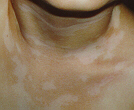 Neck and upper chest, 5-16-95.
Neck and upper chest, 5-16-95.

 Neck and back, 5-16-95.
Neck and back, 5-16-95.
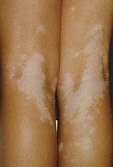
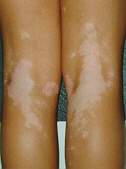 The back of her knees, 5-16-95.
The back of her knees, 5-16-95.
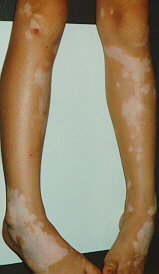
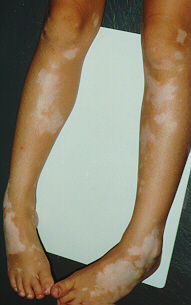 Knees, shins and ankles, 5-16-95.
Knees, shins and ankles, 5-16-95.
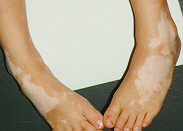

 Ankles, 5-16-95.
Ankles, 5-16-95.
Received AAD guidelines from Dr. Eells, not much use, 5-22-95.
Noticed that it started in places where she sweats, 5-23-95.
Had it on face, armpits, ankles, knees, and neck 5-24-95.
Dermatologist Moreno, diagnosed Emily with vitiligo, he was surprised at how
far along it had progressed for her age. He wanted to start PUVA immediately
and he referred her to Dr. Zies. We decided against PUVA after reading
Physicians’ Desk Reference, his report indicated it was on her neck, arms,
legs and trunk. At this point we were really questioning our own judgment,
5-24-95.
Been reading VEGAN-L and HERB listservs, 5-26-95.
Received Dr. Montes' article on vitamin therapy from the NVFI. I wrote letter to Dr. Montes and Dr.
Rebat Hadler, 5-30-95.
Started vegetarian lifestyle, also started folic acid and vitamin C treatment
(probably stopped the PABA at this time), Susie took vegetarian cooking
class, 6-1-95.
From a note on my to-do list, "Dr. Acosta mentioned that he will get a
med-line search. Should take a couple of days. Would like time to digest
information. Seemed very receptive. Would like any information I get from Dr.
Nordlund. A little skeptical about Buenos Aires research.", 6-1-95.
Took my letter to Dr. Montes to the post office, 6-1-95
Reading more about herbs and psoralen, 6-95
From a note on my to-do list, "Saturday 6-10-95 3:50 PM Emily by herself
on couch, sucking thumb, Kyle + Katie outside playing. Emily has headache.
Just recently ate a banana, not hungry. Gave her a half a kelp pill. 15
minutes later she is outside playing and happy. 2 B-50, 500 mg C, 1/2 kelp, 1
Amino Acid complex, Multi-vitamin, Cal Mag Zinc x2, and primrose oil. I don't
believe Immune system is to "strong or weak". I do believe it could
use supplementation to properly carry out its function. (Note: Strong and
weak sound like jargon words when describing the immune system. We should use
more descriptive language to describe what is actually going on.), 6-10-95
Note on my to-do list, "folacin deficiency, produces anemia. Antibiotics
particularly sulfa drugs are chemically similar to PABA. Blocks production of
folacin. Page 294 Introduction to Organic and Biological Chemistry,
Ronald M Scott, 6-12-95
Plotting her morning temperature, turned out to be borderline low, started
kelp tablets, 6-12-95.
We received mail from Dr. Montes, 6-13-95.
Wrote to Dr. Urbanek about coal tar therapy, Dr. R. W. Urbanek 1324 Victory
Blvd. Staten Island, NY 10301. My father-in-law mentioned a possible cancer
link with coal tar and I didn't look into it any further, June, 1995.
Dr. Bob Zenhausern agrees to host VSIG
at St. John's University, 6-15-95. YES!
Birth of VSIG, 6-23-95.
Finished reading May All Be Fed, 6-27-95.
Started Juicing, after talking to Mark Vigeant, 6-28-95.
Emily turns 7, 7-13-95.
Had read May All Be Fed, told Ludger Solbach we were eating all whole
foods, 7-14-95.
Stopped vitamin supplements for blood test, 7-20-95.
Started Vegan (pure vegetarian) lifestyle, 8-95.
Switched to acidophilus supplements.
Started drinking Distilled Water, 8-9-95.
Great video clip of vitiligo on Emily's neck and shins, 8-11-95.






Looking into esteem building activities for Emily (sports related). I think
that at this point we felt she might never repigment and we should prepare
her for a potentially difficult teenage life. I remember looking into Tai
Quon Do but the kids weren't interested, 8-12-95.
Joined EarthSave, 8-23-95.
Spots have spread to her legs, arms, chest, back, neck and chin, 9-20-95.
Checked vitamin levels in blood, all normal, didn't go back to using the
vitamin supplements (used occasional multi-vitamins) 10-3-95.
St. John's Wort, started taking 1 per
week (not sure when we increased it to three per week) 10-4-95.
Her vitiligo seems to be continually changing, freckles on a white spot, more
defined border on another spot, then a new spot somewhere else, 10-20-95.
Attended Orlando Health Fair, 10-95.
Vitiligo still active, some spots freckling, others depigmenting, 11-5-95.
Article in "Let's Live" about vitiligo, PABA, b-vitamins and
hydrochloric acid, 2-96.
Became lifetime members, Sunseed Food Coop 3-5-96.
Sandy Konkel offered Mind/Body Counseling, 3-10-96.
 Blurry, but this is her neck 5-96.
Blurry, but this is her neck 5-96.
Went to a SBGA meeting and heard a testimonial about vitiligo, 5-11-96
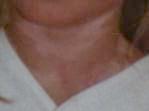 Another picture of her neck, spot
turning pink, 6-96.
Another picture of her neck, spot
turning pink, 6-96.
First session with Sandy, Mind/Body Counseling, 6-6-96.
Started taking Super Blue Green Algae, 6-10-96.
Mind/Body Counseling, 6-20-96.
Started noticing more freckling, 6-22-96.
Started taking one Catalase per day, 6-25-96.
Emily turns 8, 7-13-96.
Photo on Aunt Sandy's rocking chair, cropped to seek neck, knee and shin,
7-23-96.
 Neck, pink spots, 7-23-96.
Neck, pink spots, 7-23-96.
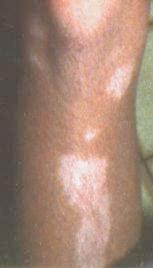 Knee and shin, pink spots, 7-23-96.
Knee and shin, pink spots, 7-23-96.
The backs of her knees have been freckling for at least two months. These are
areas about 4 inches by 2 inches that were completely depigmented, 8-8-96
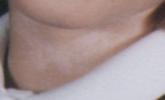 This is her neck, 9-96.
This is her neck, 9-96.
The large shape on her chest, like a monarch butterfly, is now filling in and
looks like a small bat at dusk, 9-15-96
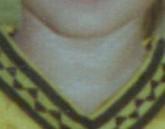 This is her neck, 10-96.
This is her neck, 10-96.
Worked the EarthSave Booth at the Orlando Health Fair, 10-30-96.
Mind/Body Counseling, 12-4-96.
Started feeling more confident about her progress, scratched vitiligo off of
to-do list, 1-97.
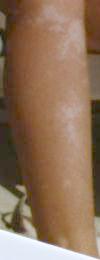 This is her shin, 3-2-97.
This is her shin, 3-2-97.
Emily is about 60% improved and holding, we are currently giving her three St. Johns Wort tablets per week 4-9-97.
Received a free copy of Dr. Montes’ book, 5-11-97.
Started taking colloidal minerals, used infrequently, once or twice a week
added to carrot juice, 5-28-97.
Started taking one St. Johns Wort per
day, 6-97.
Mind/Body Counseling, 7-2-97.
Photos, 7-97.

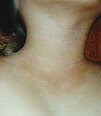
 Neck and chest, 7-97.
Neck and chest, 7-97.
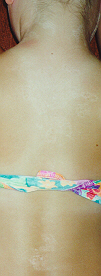
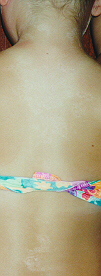 Neck and back, 7-97.
Neck and back, 7-97.
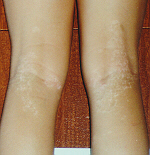
 The back of her knees, 7-97.
The back of her knees, 7-97.
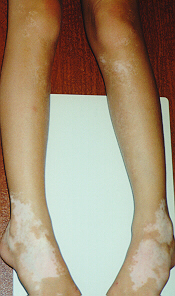
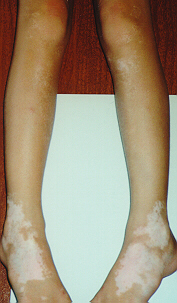 Knees, shins and ankles, 7-97.
Knees, shins and ankles, 7-97.
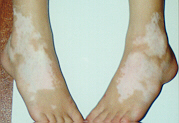

 Ankles, 7-97.
Ankles, 7-97.
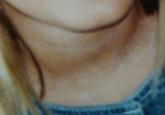 Neck, 7-97.
Neck, 7-97.
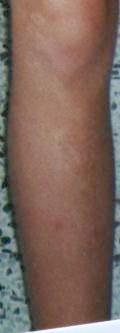 Knee and shin, some skin is actually
darker than normal, 7-97.
Knee and shin, some skin is actually
darker than normal, 7-97.
Emily turns 9, 7-13-97.
Out to dinner with Rick and Linda DeBarros, met Paul and Eric, July, 1997.
80% repigmented, she only has two plaques that don't show any sign of
repigmenting, on her ankles, 8-18-97.
Started vegetarian form of catalase, 8-20-97
Emily is fine. There has been no change in her vitiligo in the last few
months. I have been trying to work with her doctors about giving her a folic
acid injection in one of her ankles (spots where her vitiligo has not
repigmented as much as the rest of her body). It is like beating my head
against a brick wall, I feel like asking for an injection of Ritalin (bet I
would get further with that). Anyway we have been slowing down with the
supplements, as we want to give her a break for a month, December, 1997.
Finally convinced the pediatrician (Dr. Arnold) and dermatologist (Dr.
Bishop) to give her folate (2 mg/day) and vitamin B12 (200 mcg/day), they
were actually very good, just trying to cover themselves, 3-98.
Started painting her left ankle with liquid PABA once a day, took pictures,
6-6-98.
Emily is 10, 7-13-98.
Out to dinner with Tom, Carol, Tiffany, Stephanie, Whitney and Kimberly
Hernandez, 8-14-98.
She is currently repigmenting very slowly. I give her five 800 micro gram
folic acid tablets, one B100 complex, one SJW tablet, one 250 mg vitamin C
(chewable), one chewable multi vitamin, one kelp tablet, all of these are
taken daily. I occasionally give her an acidophilus capsule and a weekly
glass of carrot juice. I want to juice more often, just haven’t lately. Her
vitiligo is now mostly confined to her ankles and they are freckling. I say
mostly confined because the other areas have freckled in very well, but still
need further progress. We paint her left ankle and shin with DMAE-H3 each
night, to see if it helps any, 8-31-98.
Started using Pine Tar soap, made by Aubrey Organics, 10-1-98.
Switched over to non-chewable vitamin C, 500 mg and multi vitamin. Also
increased folic acid to six 800 micro gram tablets. Discontinued the DMAE-H3,
just didn't see much difference. 12-98.
Comparison
In
this side by side (before and after) comparison of Emily's vitiligo, you will
be able to dramatically see how much progress we have made.
Photo's on left were taken
5-95 Photo's on right were taken 7-97
Before (May ’95)
 after (July ’97).
after (July ’97).
Before (May ’95)
 after (July ’97). Neck and chest are
slowly filling in.
after (July ’97). Neck and chest are
slowly filling in.
Before (May ’95)
 after (July ’97)
after (July ’97)
 5-95
5-95  7-97. You can see a lot of glare in
some of the "after" pictures.
7-97. You can see a lot of glare in
some of the "after" pictures.
 5-95
5-95 7-97
7-97
 5-95
5-95  7-97. Big difference here
7-97. Big difference here
 5-95
5-95  7-97. And here.
7-97. And here.
 5-95
5-95  7-97. We first started seeing her
repigmenting here.
7-97. We first started seeing her
repigmenting here.
 5-95
5-95  7-97
7-97
 5-95
5-95  7-97. A little change here, but not much.
7-97. A little change here, but not much.
 5-95
5-95  7-97
7-97
 5-95
5-95  7-97
7-97
 5-96
5-96  6-96
6-96  7-23-96
7-23-96  9-96
9-96  10-96
10-96  7-97
7-97
 7-23-96
7-23-96  3-2-97
3-2-97  7-97
7-97
Picture taken on 7-23-96 is one where the disease had progressed the most. Now
you have to really look to see the vitiligo.
Go back to the timeline.
![]()
Chapter 8
VSIG and Other Resources
There
is one aspect of putting a puzzle together that I think I like most of all.
It brings the family and friends together. Who can pass a puzzle and not try
to put just one piece in. Everyone likes to feel that they helped, just a
little bit.
Talk
to someone with vitiligo
Since
this is a rare disease you may not be able to find someone who lives down the
street with it. Even if you could find someone locally with the disease you
might not want to talk face to face about it. At least that was our reaction,
when we first met people on the Internet with vitiligo we were very
apprehensive about talking to them in person about vitiligo. The non-visual
email boundary was enough for us. I think we really didn't want to see how
bad it could get. Emily's was depigmenting so fast, I was afraid that if I
met someone with a lot of vitiligo it might be too much to take. Whenever I saw
a picture of someone with a large amount of vitiligo, I projected it onto my
daughter.
I remember that John Petrik
offered his phone number when we first met on the Internet. I declined to
call. I was afraid it would lead to a meeting that I was not prepared for
mentally. Of course we are now ready and more than willing to meet others
with vitiligo. I realize that I was wrong at first. On a trip to
Seattle we did meet with the DeBarros family, their son Paul has vitiligo. We
really enjoyed ourselves and it was good therapy for Susie and me. Just to be
able to talk to other parents whose children have vitiligo, face to face, was
great. We are also thankful to have met their son's Eric and Paul.
That is what makes a vitiligo
email list so wonderful. If you are not ready or prepared mentally to meet
with others who have vitiligo, you can still talk to them. You get anonymous
support, which is what we needed at first.
Here is an example of some
of the mail I get thanking me for starting the VSIG.
Dear Eric
I am leaving the list only because I'm going away for a bit - will not have a
chance to access my mail. This list has been so very helpful to me since last
year when I was diagnosed with vitiligo. I felt that here was the only place
I could turn to where no one would stare at me and wonder what planet I came
from - in fact, people were sympathetic, considerate, helpful and most of all
very very informative. I thank you very much for your support.
Organizations
The
following organizations have helped us, by supplying information about
vitiligo. I have used some of that information in this book.
American Vitiligo Research Foundation,
Incorporated
National Institute of Arthritis
and Musculoskeletal and Skin Diseases
Box AMS
9000 Rockville Pike
Bethesda, MD 20892
(301)495-4484
National Vitiligo Foundation Incorporated
Animal Testing
We
now recommend supporting the American
Vitiligo Research Foundation Inc.; they do not support animal testing.
Why you should support an
organization that does not fund animal testing.
|
|
Animal tests have one purpose in today's medical environment; they are used to support liability defenses. |
|
|
The tests don't apply to humans; one example is that a cat will die if you feed it aspirin. |
|
|
These tests are wasteful of the human brainpower required to solve the riddle of disease. The intelligent people working on animal tests could be put to better use studying population groups, testing real human tissues and using computer models. |
|
|
Imagine if you were one of the technicians who had to do this work, day in and day out. That has to work on your psyche. In this case the animal tests are abusing the human animal. Often times IMHO these people aren't the Chief Scientist that came up with the idea of the experiment, these are the people who actually have to get their hands dirty. |
|
|
They actually obfuscate the problem. Consider that the tobacco industry used animal tests for years to show that smoking did not cause cancer. |
|
|
Animal tests and their acceptance reduce our level of compassion. It lowers the collective conscience of our society. What happens to the animals after the experiment is over? Are they sent to a sanctuary? Are their wounds healed? Do they use painkillers before they burn their skin? |
|
|
Even after animal tests, close to 50% of all drugs are removed from the market place because of adverse reactions. If the animal tests were successful, wouldn't this percentage be much lower? |
|
|
Every time a knock off drug (another generic form of the same drug) is produced it has to go through the same tests that the original generic equivalent had to go through. This has happened many times for such drugs as Valium. |
|
|
For more information on animal testing contact the Physicians Committee for Responsible Medicine (PCRM). |
Here is an
excellent article titled For
Stella Pavlides, Isolation of Vitiligo Strikes Two Ways from the Wall
Street Journal. It describes why Stella has chosen this path.
![]()
Conclusion
What
have we concluded from all of this? In a nutshell I believe that following
Dr. Montes advice with the possible addition of a natural psoralen (St. Johns
Wort in our case) along with a 1/2 hour in the sun or some time in a tanning
booth (start slowly) will correct this condition. Vitiligo won't disappear
overnight, just as many of the problems that caused it have been developing over
a long period of time.
Our shift to a pure
vegetarian lifestyle raised our intake of the vitamins Dr. Montes recommends.
It also supported our bodies in eliminating toxins, by not having to deal
with a lot of unneeded nutrients (as if cholesterol is a nutrient). I believe
it also eliminated potential triggers of vitiligo; animal protein,
sulfa-based antibiotics, pesticides.
Follow common sense rules
for healthy living, no-saturated fats, increase raw fruits and veggies,
no-cholesterol, get outside in the sun and fresh air every day (not mid-day
sun), exercise and see a therapist or share your feelings openly with your
close friends. Keep it simple; just remember how healthy a carrot can be for
your skin. You don't necessarily have to know that it contains carotenes,
calcium, fluoride, iodine, manganese, silicone, sodium, sulfur, panothenic
acid (vitamin B-6), calciferol (vitamin D), tocopherol (vitamin E),
phylloquinone (vitamin K), catalase, psoralen, just know that veggies are
good for healthy skin.
When you finally solve a
jigsaw puzzle it gives you a great sense of closure. We don't quite have that
with our vitiligo. I hope one day to say that we do. I remember as a child
hiding a piece of the puzzle in my pocket. I would help my Mom solve the puzzle,
at the end I could stick in the final piece. It isn't so important now to put
in the last piece. The enjoyment has come from working the puzzle, the
journey rather than the destination. We are, as a family, living healthier
more compassionate lives. The beauty of it all comes into focus in that as a
side benefit, Emily is visibly getting better. It is a yardstick of our
choices. Vitiligo has not only started us on our path, it has measured our
progress.
![]()
Appendix A
Internet Information
VSIG
is a group of individuals who discuss vitiligo daily via email. More
information about VSIG can be found at http://www.lsoft.com/SCRIPTS/WL.EXE?SL1=VITILIGO&H=MAELSTROM.STJOHNS.EDU.
Information on searching past posts to VSIG can be found here as well.
How to subscribe
Send email to listserv@maelstrom.stjohns.edu with the command
SUBSCRIBE VITILIGO YOUR_FIRST_NAME YOUR_LAST_NAME
in the body of the note. Of course you must substitute your real name into
the command.
It might look like
SUBSCRIBE VITILIGO MICHAEL JACKSON
Network Etiquette
VSIG
is a support group and anytime you post to it, ask yourself if what you are
doing is supportive. If not, don't post it. If you feel the need to be heard,
send it directly to the person involved or to the ListOwner (me). Also never
post a message sent directly to you, without permission to post it.
Emoticons are helpful for
displaying emotion in a text-based environment. Here are a few examples; you
have to look at them sideways.
:-) This is a smiley face.
;-) This is a wink.
:-| A straight face
:-( A frown
These are acronyms that are
used widely on the Internet.
KIT - Keep In Touch
LOL - Laughing Out Loud
ROTFL - Rolling On The Floor Laughing
TTFN - Ta Ta For Now (It's what Tigger said in Winnie the Pooh)
![]()
Appendix B
Dr. Leopoldo Montes
Dr.
Leopoldo F. Montes, MD, MS, F.R.C.P.C.
Director of Dermatology Research Structural Research Center
Mobile Professor Emeritus of Dermatology
University of Alabama at Birmingham
Birmingham, Alabama
Dr. Montes wrote:
Vitiligo, Nutritional
Therapy by Leopoldo
F. Montes
Westhoven Press
Buenos Aires, Argentina
ISBN 987-96240-0-9
My Review: This is an excellent book for those
suffering from vitiligo, it should be required reading. Dr. Montes explains
many aspects of the disease from the history of treatment to diagnosis to ideas
on nutritional therapy. There are times that a slight language barrier exists
in the book between English, Spanish and medical language. Most of the time
the message gets through to the reader. I am most pleased with the
photographs of patients and photos used to explain the disease itself. Also
included in this book are patients that have Alopecia areata (hair loss in
patches), with significant progress in hair growth.
To order this book contact
Dr. Jan Petrik
1442 Mendelssohn Drive
Westlake, Ohio 44145
USA
Email: epetrik@stratos.net
Phone: 440-835-2025
Send a Money Order or
Cashier's Check addressed to Jan Petrik in the amount of $44 if mailed within
the U.S. or $50 if mailed overseas. The book will then be sent to you by US
Postal Priority Mail.
More
Information from Jan Petrik:
PROCEDURE
FOR ORDERING DR. MONTES' BOOK
Vitiligo,
Nutritional Therapy
As you may know, my office
is now providing distribution for Dr. Montes' book Vitiligo, Nutritional
Therapy. This system of distribution has proven to be extremely effective,
especially since it has provided a much faster method of delivery in addition
to providing a guarantee of receiving the book. As many of you are aware, the
majority of people were having lots of problems when they ordered the book
from Argentina due to no fault of Dr. Montes or Westhoven Press. The supposed
disorganized and corrupt mail system resulted in many checks not reaching
their intended destination and therefore many people lost their money. This
is the reason my office decided to help in providing this service, not only
as a favor to Dr. Montes but also so that everyone could be assured of
receiving their book in a more secure and timely manner. However, I cannot be
responsible for books that are ordered directly from Argentina. If you are
interested in ordering Dr. Montes' book, here are the details. Please send a
money order or bank cashier's check addressed to Jan Petrik in the amount of $44.00
if the book is mailed in United States or $50.00 if it is mailed to a foreign
country; this includes the shipping cost. The reason for the difference
is due to the cost of shipping. Also, please e-mail me your address and phone
number in advance if possible in addition to enclosing that information when
you send your payment. Upon receipt of your payment, your book will be sent
to you by U.S. Priority Mail. The majority of people are receiving their
books within 1-5 days. However, your book may be delayed if your payment is
sent in a manner which requires signature and pickup at a designated location
due to the fact that this requires myself or office personnel to pick up your
envelope personally and sign for it. This is very time consuming and costly
for me; therefore, I would prefer that this method not be used unless you
really feel uncomfortable sending the money in a different manner.
Dr. Jan Petrik
1442 Mendelssohn Drive
Westlake, Ohio
44145
USA
Phone: 440-835-2025
E-mail: epetrik@stratos.net
Thanks very much for your courtesy in this manner. My sincerest best wishes
to all of you!
P.S. No refunds or returns
for Dr. Montes' book.
![]()
Appendix C
My Cholesterol Levels
When
viewing the graph below, remember that the cholesterol level of the average
heart attack victim is 244. You can see that at 33 I was dangerously close to
that level, 242. You can also see from the graph, that my cholesterol is now
lower than it was when I was 27. The trend is still downward and my goal is
to get it below the 150 mark. That is the level that minimizes your risk for
heart disease.
The following items
correspond to the numbers on the graph. These were different things I was
trying at the time.
1. Tried the Rinse Formula,
invented by Dr. Jacob Rinse, it was supposed to lower cholesterol. I think it
worked but it didn't taste very good.
2. I ate very little meat after
February 1995.
3. Vegan diet, started transition in
September 1995.
4. Started McDougall program.
5. Started using more fat in recipes.
6. Vegan, have not been concerned with
fats. Recently started surfing for exercise.
7. Vegan, started watching fats again
(McDougall). Still surfing regularly.
8. Vegan, watching fats, using Stevia
in morning breakfast instead of maple syrup.
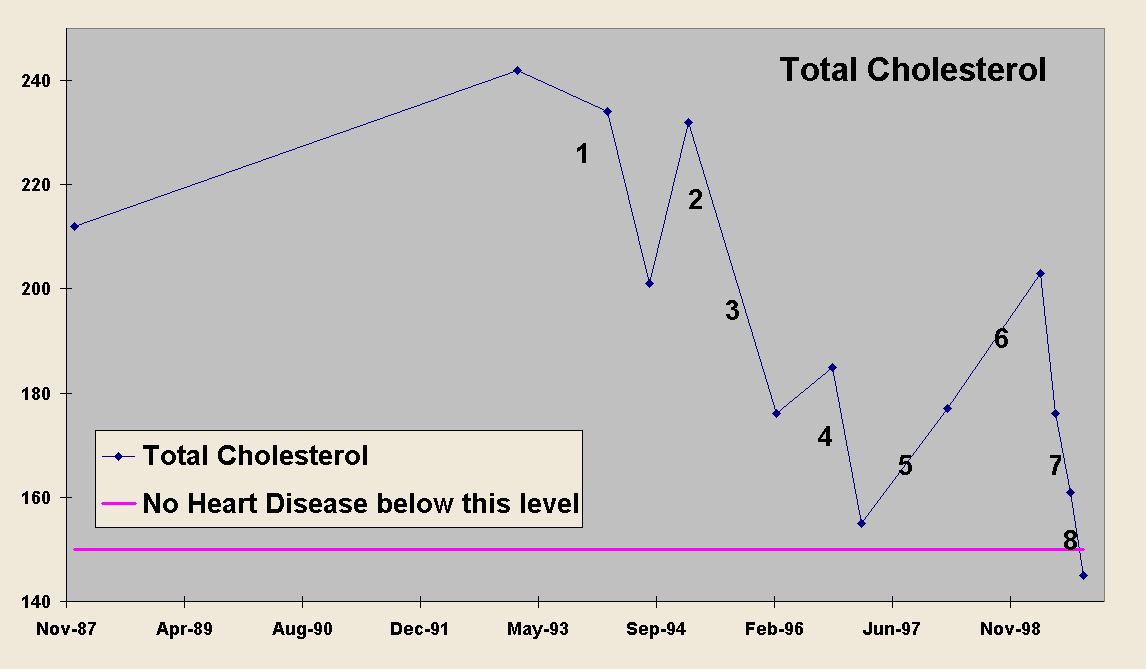
![]()
Bibliography
I
usually pick up most of my books from the local library. If you are
interested in purchasing one of these books try Amazon.com , if you don't find the book there
let them know. Especially Dr. Montes' book, it would be nice to have books
that deal with vitiligo and nutrition available on the web.
, if you don't find the book there
let them know. Especially Dr. Montes' book, it would be nice to have books
that deal with vitiligo and nutrition available on the web.
If you order
a book from this page I will be paid a percentage from Amazon.com. I receive
5% for any book ordered via the two links above, the Amazon.com search engine
and their home page. I will receive 15% from any of the direct links to books
at Amazon.com below. If a book was offered in paperback or hardback, I went
for the cheaper of the two. So thank you in advance if you order one of these
books. Sometimes Amazon.com offers good reviews for the books at the
following links.
If you would rather order
from Barnes and Noble, please follow this link: barnesandnoble.com
Diet
and Health
Apple
Cider Vinegar Health System
by Paul C. and Patricia Bragg, ND. Ph.D.
Even though I believe that using unpasteurized ACV is good for you do to the
need for active bacterial cultures in our gut; I wasn't too impressed with
this book.
Beyond Beef by Jeremy Rifkin (click
here to order this book from Amazon.com)
This is the story of our cattle culture and what it is and has done to our
environment.
Deadly Feasts: The 'Prion'
Controversy and the Public's Health
by Richard Rhodes (click
here to order this book from Amazon.com)
Well researched book about the history of spongiform encephalopathy. This
book really grossed me out and I can usually handle some gross stuff.
Diet for a New America by John Robbins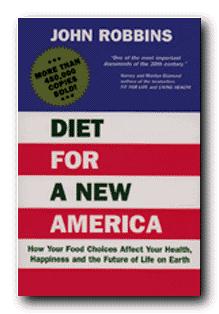 (click
here to order this book from Amazon.com)
(click
here to order this book from Amazon.com)
If you’re interested in eating more healthfully, I suggest reading this book.
If you are concerned about how you food gets to your table, this book will
validate your concerns. It is not all gloom and doom, after reading anything
by John Robbins, you realize there is a better way, a higher road.
Dr. Attwood's Low-Fat
Prescription for Kids
by Charles R. Attwood,
MD (click
here to order this book from Amazon.com)
A very successful pediatrician, he tells us why he prescribes a low-fat
vegetarian diet for kids. He also mentions that the parents seem to be helped
by it as well. What is it about children that cause a whole family to change
their ways?
Dr. Dean Ornish's
Program for Reversing Heart Disease
by Dean Ornish (click
here to order this book from Amazon.com)
Interesting to hear the effort required to get this common sense approach to
health excepted by the modern medical establishment. Dr. Ornish has proven
that heart disease can be reversed through diet and lifestyle changes.
Dr. Spock's Baby and
Child Care by
Benjamin Spock, Stephen J. Parker (click
here to order this book from Amazon.com)
Before he died, Dr. Spock revised his book. It now recommends raising your
children as vegetarians. He also recommends avoiding milk and dairy products.
Having this book available when our children were young was very helpful;
just wish this latest revision was available then.
Don't Drink Your Milk! by Frank Oski, M.D. (click
here to order this book from Amazon.com)
A doctor that say's "don't drink your milk"? He is one of many you
will read, if you read some of the books listed here.
Eat Right, Live Longer by Neal
D. Barnard, MD (click
here to order this book from Amazon.com)
Foods Can Save Your Life: Leading Experts Tell You Why by Neal D.
Barnard (click
here to order this book from Amazon.com)
Foods That Fight Pain by Neal Barnard (click
here to order this book from Amazon.com)
The Power of Your Plate by Neal D.
Barnard, MD (click
here to order this book from Amazon.com)
Neal is one of my favorite doctors and these are some of my favorite books.
He started the Physician Committee for
Responsible Medicine, of which I am now a member. He is an excellent
speaker and if you ever get a chance to see him, take it.
The Encyclopedia of
Medicinal Plants by
Andrew Chevallier (click
here to order this book from Amazon.com)
One of the best books I have ever seen on the subject of herbs. Great color
pictures of the plants, very well written, made the subject matter
interesting to me.
Enzyme Nutrition by Edward Howell (click
here to order this book from Amazon.com)
He has some very interesting theories on the operation of the digestive system.
Helped me decide that more raw foods would be helpful.
Enzymes the Fountain of
Life by Lopez,
Williams and Miehlke (click
here to order this book from Amazon.com)
Some parts were a little over my head, goes into the specific mechanisms that
allow a large enzyme molecule to enter the blood stream via the intestines.
This has been debated on VSIG.
Food Enzymes by Humbart Santillo (click
here to order this book from Amazon.com)
Short and informative book on digestion.
The Hippocrates Diet and
Health Program by
Ann Wigmore (click
here to order this book from Amazon.com)
If you are interested in adding more raw foods to your diet, this would be a
helpful book.
Introduction to Organic
and Biological Chemistry
by Ronald M Scott
This is the book that made the connection for me between antibiotic use and
folic acid depletion.
Long Life Now by Lee Hitchcox, DC (click
here to order this book from Amazon.com)
This guy helped convince me that I need to exercise as well as eating right,
and that was no small feat! This book touches every aspect of your life, even
what type of sun glasses to purchase. It is like the manual that all humans
should come with.
Mad Cowboy, Plain Truth from the Cattle
Rancher Who Won't Eat Meat
By Howard F. Lyman With Glen Merzer (click
here to order this book from Amazon.com)
Howard is the guy who caused Oprah to say "That stopped me cold from
eating another burger!” The cattlemen sued and she won. Howard is an
excellent speaker, this is a great book. Howard is now the president of EarthSave International.
May All Be Fed by John Robbins (click
here to order this book from Amazon.com)
This is the book that enlightened me about the amount of sulfa-based
antibiotics found in dairy in the United States. I had read in a biochemistry
textbook previously that these powerful antibiotics interfere in folic acid
absorption. Dr. Montes tells us how important folic acid is for healthy skin,
to order Dr. Montes book, see Appendix B.
The McDougall Program by John A. McDougall, MD (click
here to order this book from Amazon.com)
One amazing story after another, from his own personal health problem, to his
patients on Hawaii, to his patients at his clinic in Napa Valley, California.
This book is very inspiring. Dr. McDougall is another great speaker; don't
miss him if he comes to a town near you. One day I would like to go to him
for a full physical.
The McDougall Program
for Maximum Weight Loss
by John A. McDougall, MD (click
here to order this book from Amazon.com)
Great recipes.
Meatless Meals For
Working People by
Debra Wasserman and Charles Stahler (click
here to order this book from Amazon.com)
I really liked the section on vegetarian and vegan items found at fast food
or quick service restaurant chains.
Merck Manual (click
here to order this book from Amazon.com)
Mooove Over Milk by Let's Live
Nutritional Awareness
Guide by Legion of
Light
This is a laminated, legal sized card that lists vitamins and the foods that
contain them. It was a gift, a friend gave to me. He picked it up in a HFS
near San Diego.
Physician's Desk
Reference (click
here to order this book from Amazon.com)
A Pictorial Handbook of
Anatomy and Physiology
by Dr. James Bevan
Prescription for
Nutritional Healing
by James F. Balch, MD (click
here to order this book from Amazon.com)
This book is important to help understand how our bodies are affected by
different nutrients. Dr. Balch addresses just about every disease I have ever
heard of, vitiligo included.
Reclaiming Our Health by John Robbins (click
here to order this book from Amazon.com)
If you are concerned about what to do in the event of a major disease, like
cancer, get this book. I suggest reading it before you get the disease.
Reversing Diabetes by Dr. Julian Whitaker (click
here to order this book from Amazon.com)
Tissue
Cleansing Through Bowel Management
by Bernard Jensen (click
here to order this book from Amazon.com)
Warning the picture in this book are graphic and will completely turn your
stomach.
Vegan Nutrition by Michael Klaper, MD (click
here to order this book from Amazon.com)
Vegan: The New Ethics of
Eating by Erik
Marcus (click
here to order this book from Amazon.com)
Very well written with many personal accounts, I have enjoyed reading this
book.
Vitiligo, Nutritional
Therapy by Leopoldo Montes, MD
Every vitiligo patient and their family should have this book. If we had a
vitiligo parade this man would be the center of attention, he would be the
grand marshal.
Whole Health by Joseph Keon, Ph.D. (click
here to order this book from Amazon.com)
Women's Bodies, Women's
Wisdom by
Christiane Northrup, MD (click
here to order this book from Amazon.com)
Watch out, after reading this book my wife gave up caffeine.
Animal
Testing
Many
of the books in this bibliography will cause you to think outside of the
envelope, the following four books will certainly do that.
Animal Liberation by Peter Singer (click
here to order this book from Amazon.com)
I think that I was never able to consider animals feelings until I became a
vegetarian.
Environmental
The
Dream of the Earth
by Thomas Berry (click
here to order this book from Amazon.com)
Ishmael by Daniel Quinn![]() (click
here to order this book from Amazon.com)
(click
here to order this book from Amazon.com)
The Story of B by Daniel Quinn![]() (click
here to order this book from Amazon.com)
(click
here to order this book from Amazon.com)
Recipes
Cooking
Healthy With One Foot Out the Door by
Polly Pitchford and Delia Quigley
The bad girls of natural health, very funny. Great recipe for "Tofuna or
What the heck is it?". (click
here to order this book from Amazon.com)
Eat Right, Live Longer by Neal
D. Barnard, MD (click
here to order this book from Amazon.com)
From the Heart of the
Harvest Cafe by
Susan Rizzo
-2104 Woodbury Road, Melbourne, FL 32935 $10 and $2 for shipping
-This book has some really great soup recipes, I really like the
"Turkish Wedding Soup".
May All Be Fed by John Robbins (click
here to order this book from Amazon.com)
The Black Bean and Corn recipe is "to die for", I just use less
oil.
The McDougall Health-Supporting
Cookbook, Volume One
by Mary McDougall (click
here to order this book from Amazon.com)
The McDougall Health-Supporting Cookbook, Volume Two by Mary McDougall
(click
here to order this book from Amazon.com)
The McDougall Quick & Easy Cookbook by John A. and Mary McDougall (click
here to order this book from Amazon.com)
Anything by the McDougalls will lower your cholesterol, I guarantee it.
The Uncheese Cookbook by Joanne Stepaniak (click
here to order this book from Amazon.com)
Great for experimenting. We like the "Gee Whiz Spread" and the
"Fettuccine Alfonzo".
Stress
and the Mind Body Connection
You'll
See It When You Believe It
by Wayne Dyer (click
here to order this book from Amazon.com)
This book really helped me at a tough time in my life. It helped me to have a
more positive outlook on life.
The Power of Myth by Bill Moyers (click
here to order this book from Amazon.com)
Religion made much more sense to me after watching this PBS video series. The
book follows along with the show.
Journey of the Awakening by Ram Dass (click
here to order this book from Amazon.com)
Be here now, centered and aware.
Myths To Live By by Joseph Campbell (click
here to order this book from Amazon.com)
An excellent story teller. Very good book.
Lots of Dilbert comic books (click here to order this book from
Amazon.com)
(click here to order this book from
Amazon.com)
The Simple Living Guide:
A Sourcebook for Less Stressful, More Joyful Living by Janet Luhrs (click
here to order this book from Amazon.com)
She has a very enjoyable way of writing.
Your Money or Your Life by Joe Dominguez and Vicki
Robin (click
here to order this book from Amazon.com)
Helped us simplify our lives and question some of our motives and habits.
Different Just Like Me by Lori Mitchell (click
here to order this book from Amazon.com)
Written by a Mom, whose daughter has vitiligo. This book could be very
helpful if your child has vitiligo. I think it would help get the child talk
about the disease and how they feel about it. As well as talking about how
they feel about themselves.
To look at what Barnes and
Noble has to offer, go to Mind,
Body and Spirit.
Miscellaneous
Dead
Meat by Sue Coe
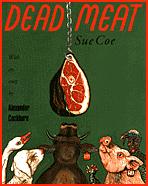 (click
here to order this book from Amazon.com)
(click
here to order this book from Amazon.com)
Might be a good coffee table book, but probably not a good dinner table book.
:-)
The Jungle by Upton Sinclair (click
here to order this book from Amazon.com)
One Up On Wall Street by Peter Lynch (click
here to order this book from Amazon.com)
The Sexual Politics of
Meat by Carol Adams (click
here to order this book from Amazon.com)
This book caused me to think differntly about the relationships I have with
the women in my life.
Living Among Meat
Eaters: The Vegetarian's Survival Handbook by Carol
Adams (click
here to order this book from Amazon.com)
A People's History of
the United States: 1492 to Present by Howard Zinn (click
here to order this book from Amazon.com)
A completely different view of our history than what we learned in school.
Toxin by Robin Cook (click
here to order this book from Amazon.com)
A co-worker of mine, Marian, came in to work claiming she had just become a
vegetarian. She knows I am a vegetarian, I guess I talk about it a lot. In
fact I have a sign on my desk that says “Vegetarian, Indian word for ‘Lousy
Hunter’”. She called her daughter and told her to come over and clear out her
freezer of meat. Marian had just finished reading a book by Robin Cook called
Toxin. Marian, a grand mother, seemed to me to be one of the last people to
change, so this peaked my interest. I went to the
library and checked out the book. Toxin is the story of a doctor whose
daughter gets sick when she is exposed to E. coli O157:H7 bacteria. She ate a
hamburger that wasn’t cooked thoroughly. It is a very suspenseful story and
it hits on all of the points that EarthSave is concerned about. I could
hardly put this book down. I don’t often read fiction,
in this case I am glad I did. I can see why Marian gave up meat after reading
it. I will be recommending this book to my friends. 7-21-99
![]()
Glossary
Addison's
Disease - I don't know much about Addison's Disease other than the
indications of it are that your forehead gets dark black pigmented spots. The
American Academy of Dermatology defines it as, decreased adrenal gland
function.
BID - means "twice
daily".
Diabetes - characterized by
excess sugar in the blood and urine.
Guttate Hypomelanosis -
Small white porcelain spots on the skin, said to be caused by sun damage.
Melagenina - An extract
made from the discarded human placenta after childbirth. The product is
applied to the skin and the patient is then exposed to 15 minutes of infrared
light. We decided against it because of concern over blood born disease.
Another reason was the product is unavailable in the US.
Pernicious Anemia - Low
levels of vitamin B12 indicate pernicious anemia.
Phytophotodermatitis -
denotes the reaction to sunlight of skin, which has been in contact with
certain species of plants.
Psoralen - causes the skin
to react when exposed to the sun. See the table of plants
that contain psoralen above.
PUVA - Psoralen
Ultra-Violet A, this is the treatment of choice by the dermatologists I
talked to. What stopped us from using it, was first the dermatologists felt
Emily was to young and the Physicians’ Desk Reference listed some
unacceptable side effects.
QD - means
"daily".
Straight Edge - A vegan
that does not use drugs.
Thyroid - A gland in your
neck that regulates your temperature. A high or low temperature level will
affect your growth. The thyroid gland needs iodine to function properly. A
good source of iodine is kelp, tablets of kelp can be found at your local
health food store.
Vegan - pure vegetarian.
Vegetarian - Eats no flesh.
There are varying forms of vegetarians.
Vitiligo - That's where
your skin develops milk-white patches that are completely devoid of pigment.
VSIG - The Vitiligo
Support and Information Group is a group of friends that talk to each
other on the internet daily about vitiligo. If you have Internet email you
can be a member of VSIG, for free.
![]()
About The Author
Eric
Fricker is the creator of the world’s first online support group for
vitiligo, VSIG.
He works with systems test software and was educated at the University of
Central Florida as an electrical engineer. He is the proud parent of three
wonderful children. Eric considers his finest achievement to be marrying, Ms.
Susie Wright of Mount Clemens, MI. Most people that know Eric and Susie would
agree. He has been told that he married up. Eric enjoys surfing, bicycling,
camping, skateboarding and is considering roller blading.
Eric is currently looking for a publisher who may be interested in promoting
this book.
![]()
Printing
This Book
I
suggest doing a print preview first, that way you will know how many pages
will print. A laser printer works great and I am sure it would look great on
a color ink-jet printer. When I print it, Netscape prints page numbers on the
bottom of each page. Remember to include the copyright
paragraph.
![]()
Very Important Update (Sunday, February 12, 2012):
Use folate supplementation not folic
acid. Better yet
you should get your folate from whole plant foods like green leafy
vegetables. In my recent readings I understand that folate is preferable over
folic acid. I understand that there may be risks with too much folic acid so
I have recommended to Emily that she take folate instead which is closer to
the form of the vitamin found in food. This article discusses the concerns
with folic acid http://www.msnbc.msn.com/id/35874922/ns/health-diet_and_nutrition/t/your-breakfast-giving-you-cancer/.
I have made this choice and I thought you should be aware of it to make your
own informed decision.
|
|
